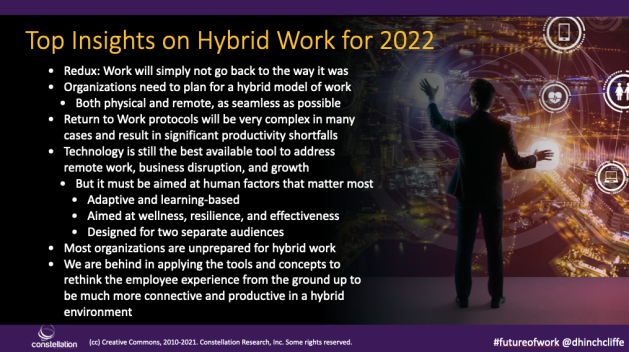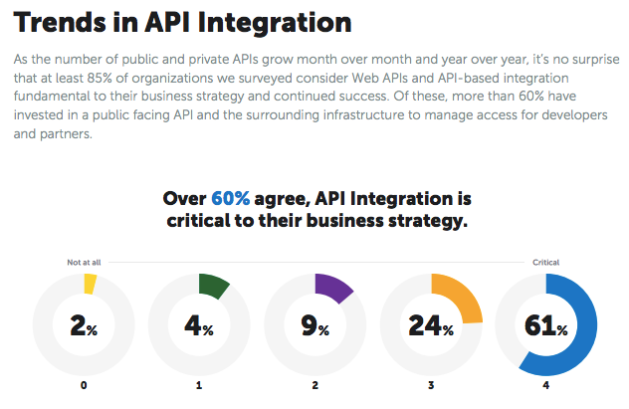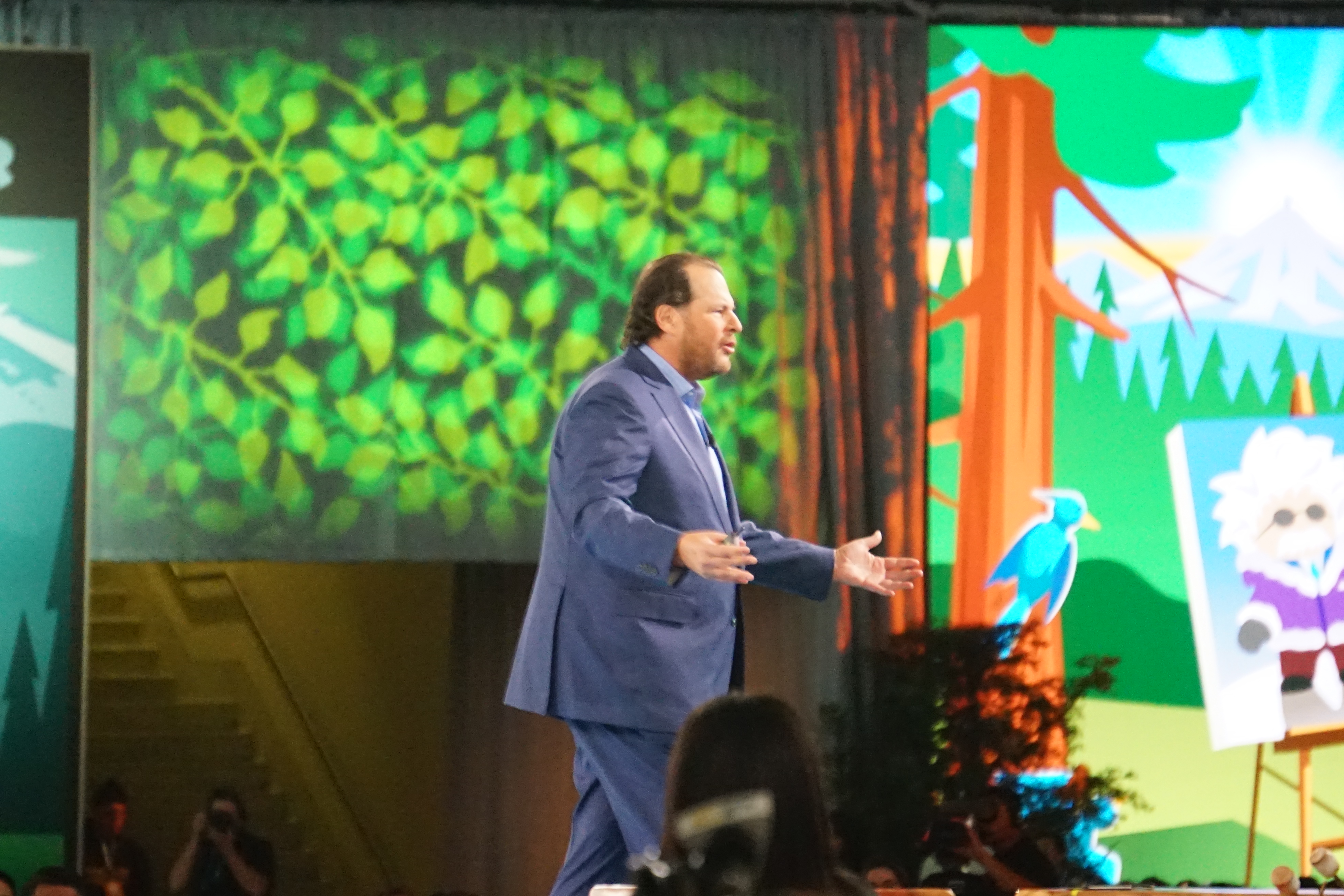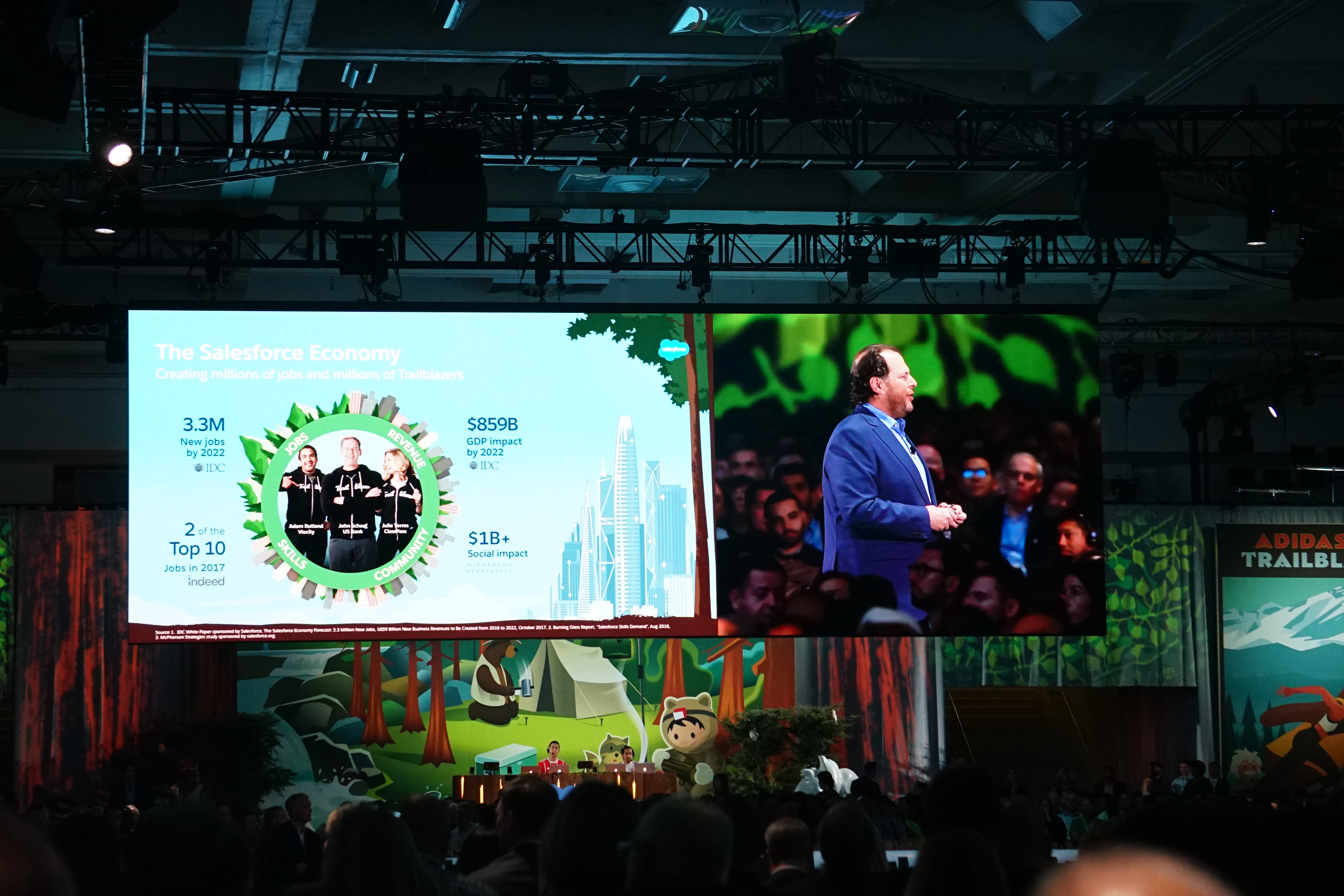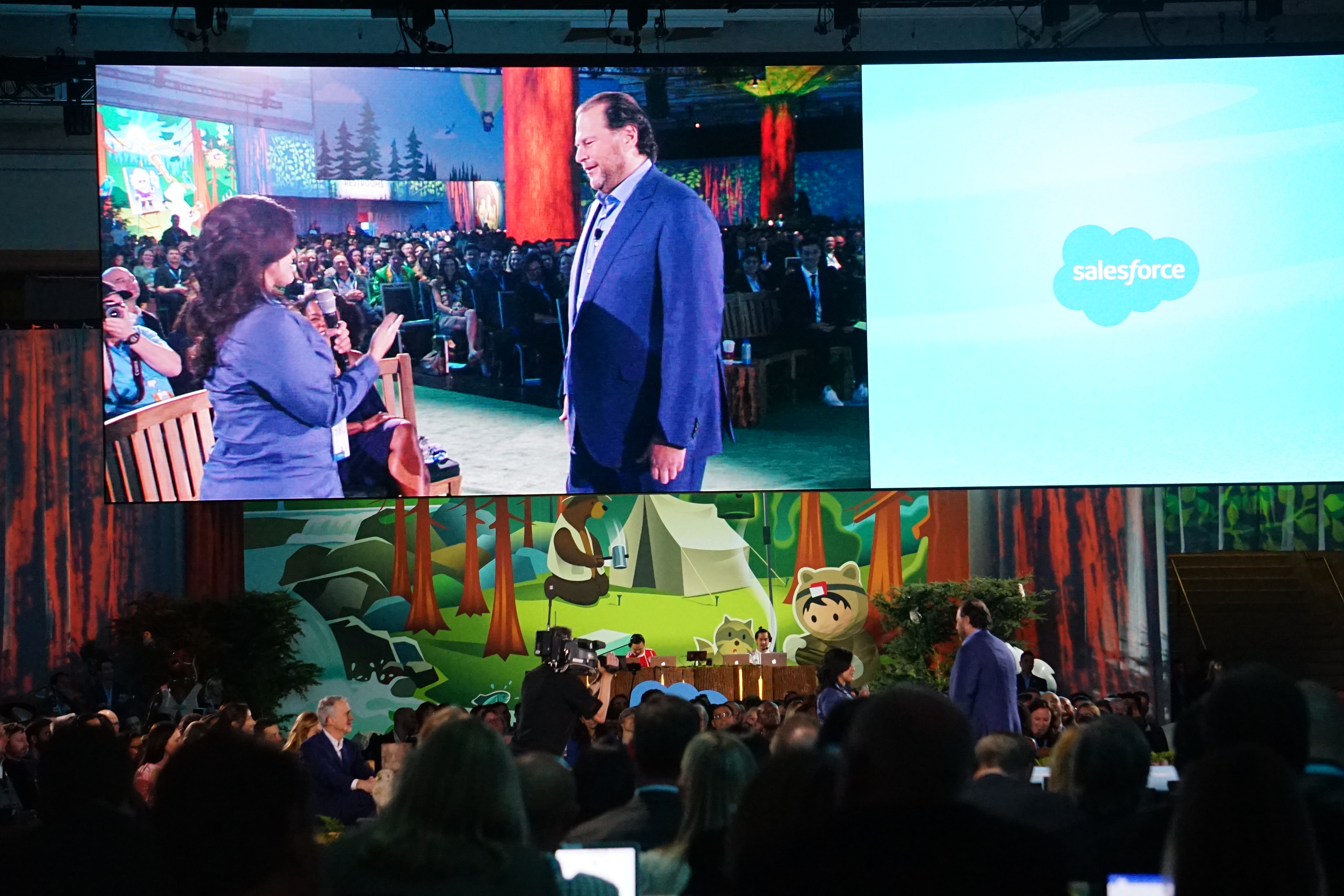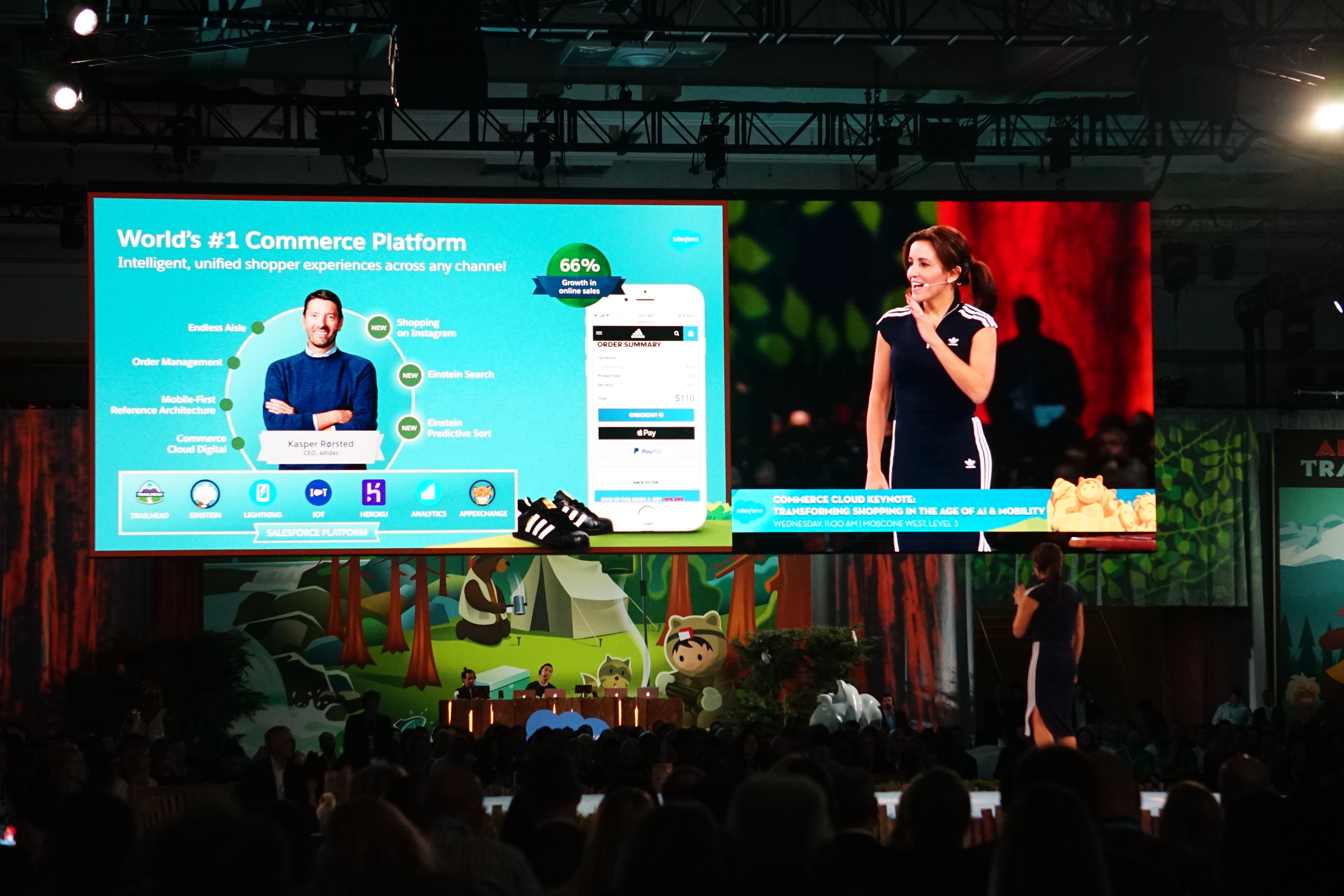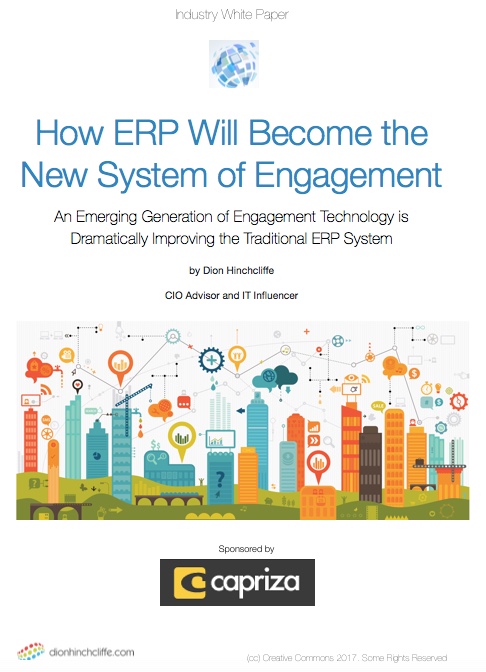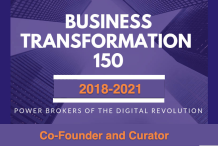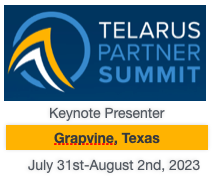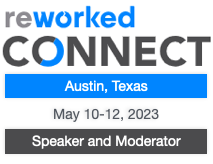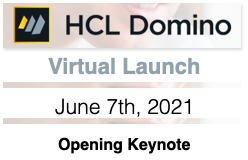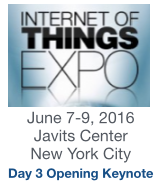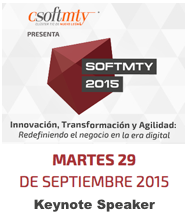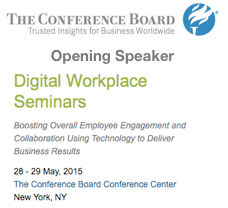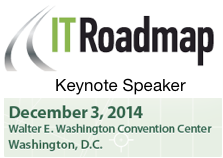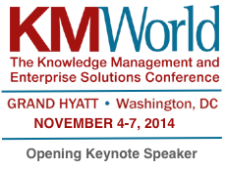A Comprehensive Guide to the Future of Work in 2030
January 18, 2024 Leave a comment
As 2024 arrives, many of us are coming to a pivotal realization: The once distant horizon of 2030 is now steadily looming. This major temporal milestone, frequently cited in futuristic forecasts and strategic plans, is no longer a distant scenario. It will arrive in just a half-decade, which is not much time at all when it comes to the rate of change within organizations today. With this critical juncture in sight, it’s now important that we shift some of our immediate focus on long-term speculation to active preparation and strategy development towards this coming era of the future of work and employment. Below, I’ll explore my latest updated view of this future, with many details. The aim: To ignite forward-thinking industry dialogue about what the future of work of work entails by the end of this decade.
Recent statistics paint an intriguing picture of our future workplace. Just one example: According to the World Economic Forum, an estimated 50% of all employees will need reskilling by 2025, as technology advancement continues to accelerate. Moreover, the International Labour Organization notes that by 2030, the global labor force is projected to reach 3.5 billion, but 85% of the jobs that will exist then haven’t been invented yet. These figures underscore a transformative shift in the nature of work, propelled by technological advancements, changing demographics, and evolving societal norms. They highlight the urgency for individuals and organizations alike to adapt, upskill, and rethink traditional employment paradigms. The following below contains a detailed exploration of what we must prepare for.
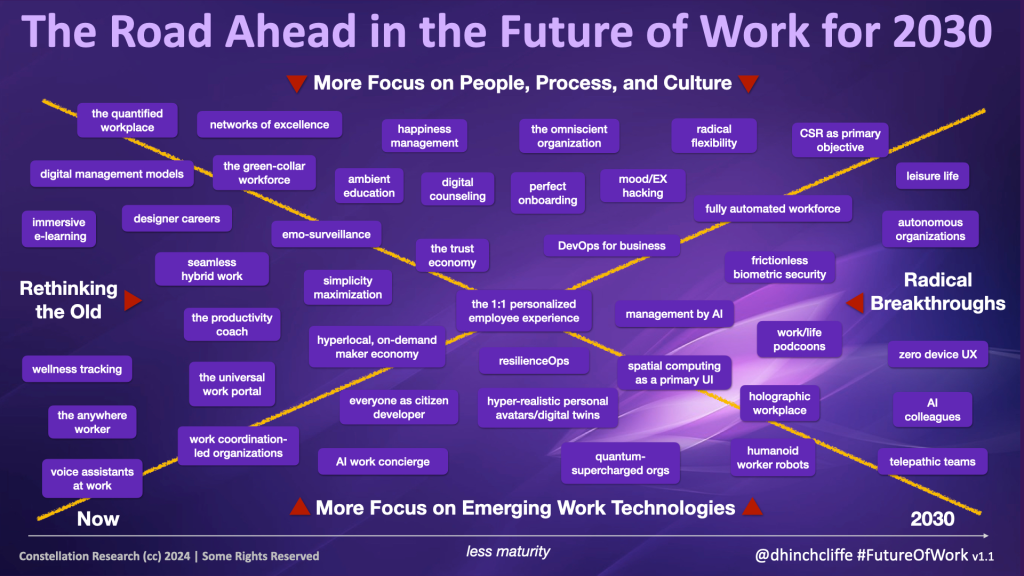
As we delve into this look into the future, I will explore several far-reaching examples of what work might look like in 2030. From the deep integration of AI and machine learning in everyday tasks to the rise of remote, hybrid, and even entirely new working models, the landscape of work is set to undergo unprecedented changes. Below is an introduction — to the degree I can make it comprehensive — of major trends that are shaping the future of work, such as the gig economy, green jobs, and the emphasis on mental health and wellbeing in the workplace. Join me on this exploratory journey, where enthusiasm for progress meets a grounded, professional analysis of what lies ahead.
The chart above summarizes an approximately 80% view of the major shifts and advances in work through 2030. The top of the chart focuses more on people, process, and culture, while the bottom is more technologically focused. Advances on the left are often already here in early form, while the trends on the right are farther out and will likely still be bleeding-edge by 2030, but clearly major trends.
Let’s jump right in, going from left to right on this future of work trends chart:
2030 Work Trends and Advances
The Quantified Workplace
Those who attend my talks know that often quote Peter Drucker’s famous adage, “If you can’t measure it, you can’t manage it.” This principle has never been more pertinent than in today’s quantified workplace, where the rise of workplace analytics has revolutionized how we approach productivity and efficiency. The advent of Objective and Key Results (OKR) tracking, sophisticated analytics and Business Intelligence (BI) dashboards, and even digital twins of work processes, have transformed the landscape of organizational management. These tools not only provide a granular view of performance but also empower decision-makers with actionable insights, fostering a culture of continuous improvement and strategic alignment.

An Operations Team Using Workplace Analytics To Manage Work
The well-known story of Google, for instance, who has long been a proponent of OKR tracking to ensure that its teams’ efforts align with the company’s ambitious goals. Similarly, Siemens has embraced the concept of digital twins, creating virtual replicas of their work processes in high-impact environments like healthcare to optimize operations and predict future scenarios. On the tool front, platforms like Microsoft Workplace Analytics and ActivTrak have become indispensable in translating data into intuitive, actionable insights for businesses of all sizes. These applications enable companies to visualize and analyze data trends, driving more informed decision-making. Another notable mention is Smartsheet, a project management tool that integrates OKR tracking within its platform, making it easier for teams to align their daily tasks with broader organizational objectives. Through these examples, we see a vivid picture of the quantified workplace in action, where every aspect of work is measurable, manageable, and, most importantly, improvable.
Digital Management Models
The hybrid work environment, a norm in today’s business landscape, is not just reshaping where we work, but also how we are managed and lead. Emerging from this paradigm shift are new management models like network leadership and distributed autonomous organizations (DAOs), which leverage technology to decentralize decision-making and promote a more collaborative and agile approach. These models are a departure from traditional hierarchical structures, emphasizing the importance of connectivity and distributed authority. For instance, network leadership thrives on the premise of connecting people across various departments and geographies, fostering a culture of open communication and shared leadership. DAOs, on the other hand, represent an even more radical shift, based on emerging management platforms that rely on blockchain technology and smart contracts to create transparent, self-governing organizations where decisions are made collectively, without centralized control.

Management Methods Are Evolving and Transforming Due to Technology
For most organizations, adopting these new management models is a challenging yet crucial transformation. It requires a significant shift in mindset from both leaders and employees, as well as a robust technological infrastructure. More freeform tools like Slack and Microsoft Teams have become instrumental in facilitating network leadership, offering platforms for seamless communication and collaboration irrespective of physical location. These tools help break down silos and enable a flow of information that is essential for a networked approach to management. Similarly, platforms like Aragon and Boardroom are specifically designed to support DAOs, providing the necessary framework for decentralized decision-making and governance. This shift is critical because it aligns with the evolving nature of work, where flexibility, adaptability, and employee empowerment are key. As the workforce becomes more global and diverse, these new management models, supported by the right tools, pave the way for more inclusive, efficient, and responsive organizations.
Immersive e-Learning
With the pace of change today required rapid reskilling and upskilling, the landscape of e-learning has been steadily undergoing a revolutionary transformation, with immersive e-learning emerging as a key trend. This evolution is characterized by the interplay and integration of experiential learning, augmented reality (AR) training, and microlearning, offering learners not just information, but experiences that enhance retention and application. Experiential learning provides a hands-on approach, allowing learners to engage in simulations that mimic real-world scenarios. Augmented reality, on the other hand, brings an interactive dimension to learning, overlaying digital information in the real world, thus offering a more engaging and effective learning experience. Microlearning breaks down content into small, manageable units, making it easier for learners to digest and retain information. These methods are gaining traction for their ability to provide flexible, impactful, and learner-centric experiences.

Digital Learning Must Occur Almost Continuously in the Modern Workplace
In the realm of e-learning products, platforms like Coursera and Udacity stand out as exemplars. Coursera offers a wide range of immersive courses that leverage video lectures, interactive exercises, and peer-to-peer learning. Udacity, with its nanodegree programs, focuses on skill-based learning enhanced by real-world projects and mentorship, aligning with microlearning principles. Companies like Boeing and Walmart have been early adopters of these new e-learning methods. Boeing utilizes AR for training its workforce, enabling them to visualize complex aircraft systems for better understanding and maintenance. Walmart has embraced virtual reality (VR) training in its academies, providing employees with lifelike simulations of in-store experiences. These examples highlight how immersive e-learning is not just an educational tool but ben an increasingly strategic asset for workforce development in various industries during the rest of the decade.
Wellness Tracking
Cultivating the health of workers via digital aids is a burgeoning new field that sits on the intersection of technology and health. Wellness tracking is steadily gaining prominence in both personal and corporate settings. Products like Fitbit and Apple Watch have become household names, renowned for their ability to track various health metrics such as heart rate, activity levels, and sleep patterns. These devices not only provide users with detailed insights into their physical wellbeing but also encourage a more proactive approach to health. Corporate wellness platforms like VantageFit have emerged to create custom AI-powered health programs. Corporations are increasingly incorporating these tools into their employee wellness programs. For example, organizations like Emory University and Google have integrated wellness tracking into their employee benefits, offering subsidies for fitness trackers and incentivizing employees to maintain a healthy lifestyle. By integrating these devices, these companies aim to foster a workforce that is not only more productive but also happier and healthier.

Wellness Tracking and Worker Health Measurement is Becoming a Leading Employee Benefit
Looking towards 2030, digital wellness tracking is poised to evolve in both sophistication and scope. The integration of AI and machine learning will likely lead to more personalized health insights and recommendations, based on individual data trends. We will likely see these devices becoming more integrated with medical systems, providing real-time health data to healthcare providers, potentially detecting health issues before they become serious. Additionally, the proliferation of wearable technology will likely expand beyond just fitness trackers to include smart clothing and even implantable devices, offering even more detailed and continuous monitoring. This evolution will not only transform how individuals manage their health but also how companies approach employee wellness, potentially leading to a more holistic and preventive healthcare model in the workplace, a benefit that top-tier employers will increasingly be expected to provide.
The Anywhere Worker
This trend represents a paradigm shift in the modern workforce, encapsulating the complete untethering of employees from traditional constraints of location, time, and collaboration mode. Propelled significantly by the fast-receding pandemic, this trend has rapidly evolved from a necessity to a widely embraced work model. The essence of working from anywhere lies in its flexibility, allowing employees to operate effectively irrespective of their physical location, be it from home, a café, or even a different country. This model not only accommodates various time zones and work schedules but also embraces diverse modes of collaboration, ranging from virtual meetings to asynchronous communication. Tools like Zoom for video conferencing, Slack for team communication, and Viva Engage for organization-wide mass collaboration have become indispensable in supporting this mode of work. They enable seamless collaboration across geographies, fostering a connected yet dispersed workforce.

As we head deeper into the decade, the work from anywhere trend is expected to deepen and expand, with technology playing an even more pivotal role. We will witness the emergence of more sophisticated collaboration tools, which will leverage augmented and virtual reality to simulate in-person interactions in a virtual space. The widespread adoption of AI for automated scheduling and language translation will further facilitate global collaboration, breaking down language barriers and optimizing workflows across time zones. Companies like GitLab and United HealthGroup have already set precedents by operating either fully remote (GitLab) or extensively remote (UHG), showcasing the viability and benefits of this model. As organizations continue to embrace and support international work from anywhere, I anticipate the growth of an ever-more inclusive, capable, and flexible global workforce, one that transcends traditional office boundaries and offers unprecedented freedom and autonomy to the individual worker.
Voice Assistants at Work
As voice assistant technology continues to improve and adapt to professional settings, its presence in the workplace is set to become increasingly commonplace. Enhanced by advancements in natural language processing and machine learning, voice assistants are evolving beyond basic tasks to handle more complex, work-specific functions. They are becoming adept at managing schedules, setting reminders, transcribing meetings, and even providing real-time language translation. The potential for voice assistants to streamline workflows, boost productivity, and foster more efficient communication is significant. One of the most powerful use cases lies in their ability to integrate with various workplace tools and systems, allowing employees to interact with and access a range of services through simple voice commands. This integration not only saves time but also creates a more intuitive and accessible work environment, particularly beneficial in hands-free or multitasking scenarios.

By the end of the decade, the fuller unleashing of voice assistants’ value in the workplace is expected to occur with the integration of generative AI connected to private Large Language Models (LLMs) of corporate data. This will enable voice assistants to provide highly tailored, context-aware responses and insights, drawing from a vast repository of company-specific information. Imagine a voice assistant that can not only schedule a meeting but also provide relevant files, participant profiles, and historical data pertinent to the discussion. An example of a successful implementation of a voice assistant in professional settings is IBM Watsonx Assistant. It can be employed in offices or facing customers to manage both employee and customer service. IBM Watsonx Assistant represents the early stages of this trend, with future iterations likely to offer more sophisticated, AI-driven functionalities, deeply integrated into corporate ecosystems, thereby transforming how we interact with technology at work.
Networks of Excellence
I’ve been tracking for years how the traditional concept of a Center of Excellence (CoE) has been undergoing a significant transformation, evolving into a ‘Network of Excellence’ (NoE) to facilitate large-scale, decentralized change management. This shift is driven by the need for organizations to adapt rapidly and efficiently in a dynamic business environment. A Network of Excellence leverages distributed participation, tapping into a wider pool of expertise and perspectives across various departments and locations. This approach is markedly different from the centralized structure of a CoE, as it promotes a more inclusive and collaborative model of change management. Enabling technologies for this transition include mass collaboration tools and work coordination platforms like Asana, which allow for streamlined project management and communication across disparate teams. Furthermore, platforms from Sensei Labs are emerging as crucial tools for transformation, providing a framework for tracking progress, sharing knowledge, and driving collective action towards common organizational goals.

Networks of Excellence Allow the Organization to Tap Into its Entire Capacity for Change
In the realm of decentralized, agile change networks, a notable example is found in the retail giant, IKEA. Over the years, I’ve been both involved in and tracking such decentralized change models, which have now been adopted by some of the largest organizations in the world, including General Electric Co., United Technologies Corp., Atlas Copco, Metso Oyj, and Ingersoll Rand. They have embraced — at least in part — a more networked approach to change, moving away from traditional, hierarchical structures. They have implemented a decentralized network of excellence, empowering teams across different countries and departments to collaborate and innovate. This approach has allowed them to rapidly adapt to market changes, such as the shift towards e-commerce and sustainable practices. By leveraging digital platforms for communication and project management, change networks in these organizations coordinate effectively, driving initiatives that are both locally relevant and globally aligned. By the end of the decade, networked and technology-fueled forms of transformation are expected to become commonplace in organizations. The integration of advanced technologies such as AI, machine learning, and predictive analytics into these platforms will further enhance their capability to manage complex change initiatives. This evolution will lead to more agile, responsive, and effective organizational transformations, with a greater emphasis on collective intelligence and distributed leadership.
Related Research: My research report on How a Transformation Platform Reimagines Success (reprint)
The Green-Collar Workforce
The rise of a green-collar worker this decade marks a significant shift in the global workforce, reflecting the increasing importance of environmental sustainability in every industry sector. Green-collar workers are those employed in fields specifically geared towards creating and maintaining a sustainable environment. This encompasses a wide range of roles, from renewable energy engineers to sustainability consultants. As the world grapples with climate change and environmental degradation, the demand for these roles is surging, driven by both societal expectations and regulatory requirements. By 2030, as sustainability initiatives gain even more prominence, the green-collar workforce is expected to expand substantially, not just in numbers but also in the scope of their roles. This growth is significantly influenced by technological advancements in areas like green IT, where professionals are tasked with developing and implementing technologies that reduce the carbon footprint of IT operations and promote energy efficiency. Sustainability can even become a business model in its own right as waste head from IT and manufacturing systems can be sold on the open market, and green-collar workers will be leading this dramatic shift in corporate priorities.

The integration of technology in sustainability initiatives is a key driver for the expansion of the green-collar sector. Innovations in renewable energy technologies, waste management, and smart infrastructure are creating new opportunities for skilled professionals. Technologies like AI and big data are increasingly being used to analyze environmental data, optimize resource use, and improve decision-making processes in sustainability projects. Companies like Siemens and Schneider Electric, known for their commitment to green technologies, are at the forefront of this transition, employing a growing number of green-collar workers to develop and manage their sustainable solutions. By 2030, as more companies integrate sustainability into their core business strategies, the role of the green-collar worker will become much more central, not just in executing sustainability initiatives but also in shaping corporate policies and practices towards a more sustainable future. This trend represents a pivotal shift in the workforce, where technology and environmental stewardship converge to create jobs that are both impactful and essential for the planet’s future.
Designer Careers
The evolution of designer careers, particularly within the realm of white-collar gig work, is reshaping the traditional job market. These careers are characterized by the freedom and flexibility for professionals to choose projects that align with their passions and expertise, facilitated by dynamic project platforms. This trend is gaining significant traction in fields like IT and management consulting, where skilled workers are increasingly opting for gig work that allows them to build diverse and impressive portfolios. By engaging in a variety of projects, these workers not only enhance their skill sets but also gain exposure to different industries and organizational cultures. This shift is driven by a growing desire among professionals to be more loyal to their career trajectory than to any single company, while also achieving maximum flexibility in their work lives, from hours worked to location. They seek to craft a career path that is not only professionally rewarding but also personally fulfilling. My Gig Economy in the Enterprise ShortList tracks the top ecosystems, while my related research has tracked the rising popularity and higher effectiveness of gig work in the enterprise sector.

The white-collar gig economy has seen substantial double-digit growth in the last several years, thanks to platforms that connect freelance professionals with organizations seeking specialized skills for short-term projects. This model has proven particularly successful in fields that require high-level expertise and experience, such as management consulting, digital marketing, and software development. Companies like Toptal and Upwork Enterprise exemplify this trend, offering a marketplace for top-tier professionals to engage with businesses on a project-by-project basis. These platforms not only provide flexibility and autonomy to workers but also allow companies to tap into a global talent pool, ensuring they have the right skills for specific project needs. As this model continues to mature, it is likely to further disrupt traditional employment models, with more professionals choosing to navigate their careers as a series of strategic gigs, shaping their professional journey one project at a time.
Related Research: Every Worker is a Digital Artisan of their Career Now
Seamless Hybrid Work
As we move towards 2030, the concept of hybrid work is set to become more seamless and efficiently integrated into our professional lives. Initially, the transition to hybrid work posed significant challenges, primarily in maintaining effective communication and collaboration across remote and in-office teams. Issues like lack of inclusion between remote and office workers, inadequate home office setups, and the struggle to preserve work-life balance were common. However, as organizations continue to adapt and vendors update their solutions to better support hybrid work, these hurdles are being overcome through a combination of innovative technologies and evolved work practices. Advanced collaboration tools are being developed to facilitate smoother interactions, such as enhanced video conferencing systems and asynchronous collaboration practices that offer more interactive, engaging, hybrid-friendly meeting experiences. AI-driven platforms are emerging to optimize scheduling across time zones and manage project workflows more effectively. Moreover, companies are adopting flexible policies that acknowledge the unique challenges of remote work, such as providing allowances for home office setups or implementing ‘no meeting’ days to combat Zoom fatigue.

An excellent example of company embracing the hybrid work model is Deloitte. Known for its consulting and financial advisory services, Deloitte has implemented a “hybrid-inclusive” approach that allows employees to blend in-office and remote work. This model is supported by a strong digital infrastructure, but also by a culture that values flexibility, employee autonomy, and work-life balance. Deloitte has focused on ensuring that its workforce, regardless of location, has equal access to opportunities and resources, thereby fostering a sense of inclusion and equity across its distributed teams. In terms of technology support, tools like Slack have been instrumental in enabling this transition for companies like Deloitte. Slack’s platform facilitates real-time communication and collaboration, making it easier for teams to stay connected and productive, whether they are working from home, the office, or anywhere in between. This approach by Deloitte, supported by innovative collaborative technologies, exemplifies how non-tech companies can effectively adapt to and thrive in a hybrid work environment, creating a resilient and adaptable workforce. I predict that most organizations will operate more like Deloitte by the end of the decade.
The Productivity Coach
The recent advent of generative AI is now set to revolutionize the workplace by introducing personalized productivity coaches for both workers and managers. These AI-driven coaches are designed to analyze an individual’s work patterns, preferences, and performance metrics to provide customized recommendations for enhancing productivity. By leveraging large datasets and learning from a user’s interactions, these AI systems can offer insights into optimizing workflows, managing time more efficiently, and improving the quality of output. For instance, a generative AI coach might analyze a programmer’s coding habits and suggest more efficient algorithms or shortcuts, or advise a manager on how to structure team meetings more effectively to boost engagement and outcomes. The potential of these AI coaches extends beyond mere productivity enhancement; they could also help in identifying skill gaps and recommending tailored learning paths, thereby contributing to ongoing professional development.
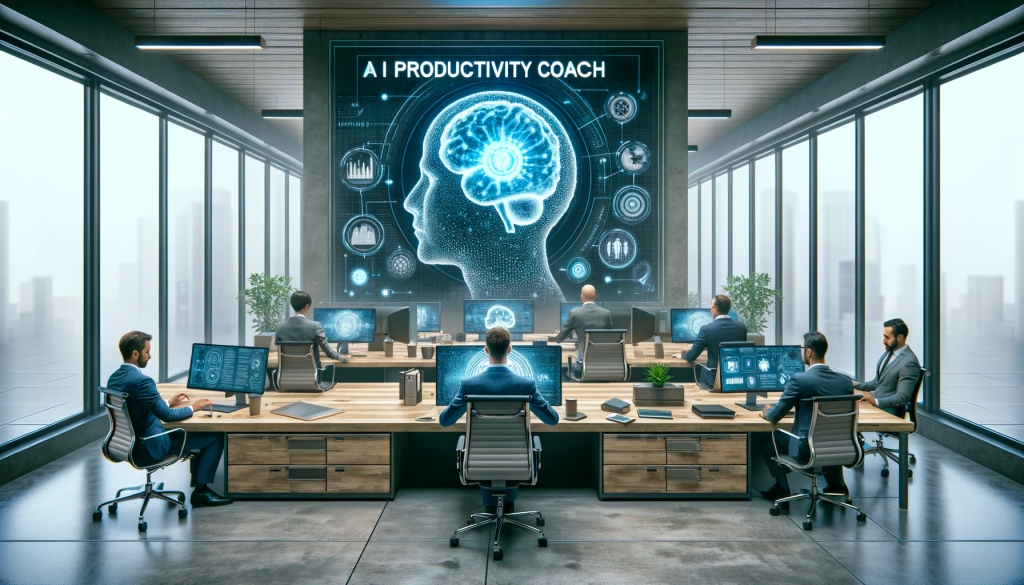
As we progress through the decade, these AI-driven productivity coaches are likely to become integral to both corporate results and employee success. In an increasingly competitive and fast-paced business environment, the ability to continuously improve and adapt is crucial. AI coaches will serve as a continuous feedback mechanism, helping employees and managers to not only work smarter but also ensure their well-being by preventing burnout and maintaining work-life balance. An example of such a solution is Poised, which uses AI to assist employees in improved communication by providing live coaching of their actual communication. This AI coach will not only enhance individual performance but also contribute to a more efficient, innovative, and adaptive sales, marketing, and product management teams. The holistic approach of these AI systems, which considers both professional output and personal well-being, aligns perfectly with the evolving priorities of the modern workforce, where productivity is increasingly seen as a function of employee satisfaction and engagement.
The Universal Work Portal
The concept of universal work portals is emerging as a groundbreaking solution in the quest to centralize and streamline the employee experience. Going far beyond the scope of traditional intranets or digital workplace hubs, these integrated portals — which I’ve predicted for several years now — are envisioned to serve as a singular, cohesive platform for a multitude of essential work-related activities. Encompassing both core work functions and support tasks, universal work portals will offer a centralized location for activities such as filing hours, managing notifications, reviewing approvals, coordinating work, and creating work output across various applications. This integration aims to address the current fragmentation in work and communication apps, reducing the cognitive load on employees and enhancing productivity. An AI-assisted layer within these portals will provide intelligent assistance, offering personalized recommendations, automating routine tasks, and facilitating more efficient workflows. The portal will not only aggregate information and tools but also intelligently prioritize and present them based on individual roles and tasks, creating a more focused and efficient work environment.

Intranets Won’t Die, But They Will Become Much More Powerful Hubs that Focus on Outcomes
By 2030, universal work portals are predicted to evolve into far more immersive and interactive platforms, potentially becoming integral parts of a broader work metaverse. As virtual and augmented reality technologies mature, these portals could transform into 3D virtual workspaces, offering an immersive experience that blurs the line between physical and digital work environments. In this context, employees could navigate a virtual office space, interact with colleagues in a more lifelike manner, and engage with work tools and data in a spatial, intuitive way. This evolution will likely see the integration of more advanced AI capabilities, further personalizing the employee experience and optimizing work processes. The work metaverse could also extend to include elements of gamification and social interaction, making work more engaging and fostering a stronger sense of community and collaboration among remote teams. As these platforms become more sophisticated and integrated into daily work life, they could revolutionize not just how we work, but also how we perceive and experience our professional lives.
Work Coordination-Led Organizations
Collaborative work management tools like Smartsheet and Asana are increasingly becoming the backbone of how work is conducted in team and project-based environments. These platforms have evolved from mere task management tools to comprehensive work operating systems for companies, offering a centralized space for detailed task tracking, management controls, and work analytics. They are specifically designed to drive outcomes by enhancing visibility, accountability, and collaboration across teams. By breaking down projects into manageable tasks, assigning responsibilities, and setting deadlines, these tools ensure that everyone is aligned and aware of their roles and deadlines. Moreover, their integrated work analytics provide valuable insights into team performance, project progress, and potential bottlenecks, enabling managers to make informed decisions and adjustments. These platforms also facilitate communication and file sharing, reducing the need for lengthy email threads and meetings, thereby streamlining workflows and increasing efficiency.

Work Coordination Now a Leading Way for Organizations to Digitally Instrument Project Work
Looking ahead to 2030, based on the growth I’ve seen within organizations today, I predict that collaborative work management platforms will continue to evolve significantly, becoming even more ingrained and central in the way work is structured and conducted. As AI and machine learning technologies advance, these platforms will likely offer more predictive and prescriptive analytics, proactively identifying issues and suggesting optimal workflows. They might also integrate more deeply with other business tools, becoming a central hub for all work-related activities, including communication, resource planning, and even decision-making. The evolution of these platforms could also see the incorporation of more immersive interfaces, such as augmented and virtual reality, making remote collaboration more interactive and engaging. This will lead to the creation of virtual workspaces where team members, irrespective of their physical location, can collaborate as if they were in the same room. As these platforms become more sophisticated and user-friendly, they will likely play a crucial role in shaping organizational cultures, fostering transparency, agility, and a more outcome-driven approach to work.
Happiness Management
A somewhat unexpected trend that I began to see as the first millennial CIOs reached the workforce and created very different IT departments, the utilization of digital sentiment analysis in the workplace represents a significant shift in how employers measure and manage employee happiness and their mental state overall. Best-in-class employers are increasingly recognizing the importance of providing an environment that caters to workers’ needs, fostering not just productivity but also engagement and fulfillment. Digital sentiment analysis tools use AI and machine learning algorithms to gauge employee sentiment through various data points, such as feedback surveys, social media posts, and even internal communication patterns. By analyzing this data, employers can identify trends in employee morale, satisfaction, and engagement, turning these insights into actionable strategies. Key Performance Indicators (KPIs) for happiness are being established, allowing companies to track the effectiveness of their initiatives and policies. More than just measuring, these tools also enable employers to proactively create positive interactions and interventions. For example, if sentiment analysis detects a trend of increasing stress levels, employers can implement specific wellness programs or workload adjustments to address the issue.
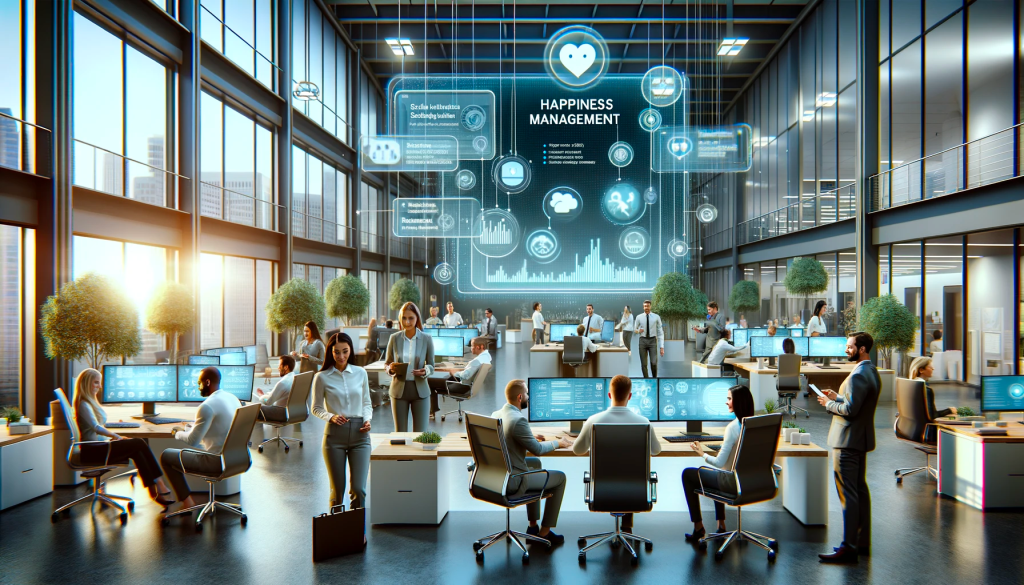
An example of a solution that embodies this approach is the platform provided by Qualtrics, which offers tools for employee experience management, including sentiment analysis. Qualtrics enables organizations to gather and analyze employee feedback in real time, offering insights that help in enhancing employee happiness and engagement. A company that has effectively integrated such a system is, perhaps unsurprisingly based on the early experience I cited abovce, is SAP. They utilize Qualtrics to understand their employees’ sentiments and needs continuously. This approach allows SAP to tailor their workplace environment and policies actively, ensuring they align with their workforce’s evolving expectations. By regularly measuring employee sentiment and acting on the insights provided, SAP demonstrates a commitment to creating a workplace where employees feel valued, engaged, and motivated. This proactive approach to managing employee happiness is not just about improving productivity; it’s also about building a work culture that supports the overall well-being and satisfaction of every team member, setting a standard for how modern organizations should strive to operate. I predict this practice will become far more common in HR and employee experience teams by 2030.
Ambient Education
The future of workplace education is poised to transcend traditional e-learning models, evolving into what is being termed as Ambient Educatin. This innovative approach integrates education seamlessly into the very fabric of the workplace, making learning an intrinsic part of the work process. Unlike conventional learning systems that require separate engagement, Ambient Learning is delivered through digital adoption platforms and other context-specific education experiences, providing real-time, on-the-job training and guidance. This method is particularly effective in training workers in both technology and business-related skills, as it offers immediate, practical applications of knowledge within the workflow. For instance, a salesperson could receive instant tips and insights about a product or customer interaction protocols directly within their sales software, or a data scientist could be trained on a new machine learning algorithm as they first use it. Ambient Education leverages advanced technologies like AI and machine learning to analyze the worker’s tasks and provide relevant, just-in-time information and training, thereby enhancing productivity and skill acquisition simultaneously.

By 2030, I predict that Ambient Education will become a leading method for continuous education in the workplace. This shift is driven by the increasing need for agility and adaptability in a rapidly changing business environment. Workers will need to continuously update their skills to keep pace with technological advancements and evolving business practices. Digital adoption and in-the-flow learning platforms, such as WalkMe and Spekit respectively, are already paving the way for this transition. These platforms offer interactive, context-sensitive guides and training within applications, enabling users to learn and adapt to new software quickly and efficiently as they work. By integrating learning directly into the work process, Ambient Education not only streamlines skill development but also ensures that the learning is immediately applicable and relevant. This approach represents a significant evolution in how knowledge is acquired and applied in the workplace, making continuous learning an effortless and integral part of everyday work activities.
Emo-Surveillance
While the concept of emo-surveillance in businesses raises legitimate concerns about privacy, it’s essential to acknowledge its potential for positive impact. Imagine workplaces where security threats are identified before they escalate, where tailored support fosters greater employee well-being, and where the pulse of the workforce informs empathetic design solutions. It’s worth considering the flip side of the coin.
Much like customer experience research utilizes emotional analysis to improve service and tailor offerings, applying similar tools to understand employees offers a profound opportunity. By subtly capturing and interpreting employees’ emotional states, organizations can identify those under undue stress, struggling with burnout, or even contemplating risky behavior. This, in turn, paves the way for proactive interventions like personalized counseling, flexible work arrangements, and targeted wellness programs. In the same way that understanding customer journeys has revolutionized service, understanding employee journeys – their frustrations, anxieties, and moments of joy – can revolutionize workplace design and culture.
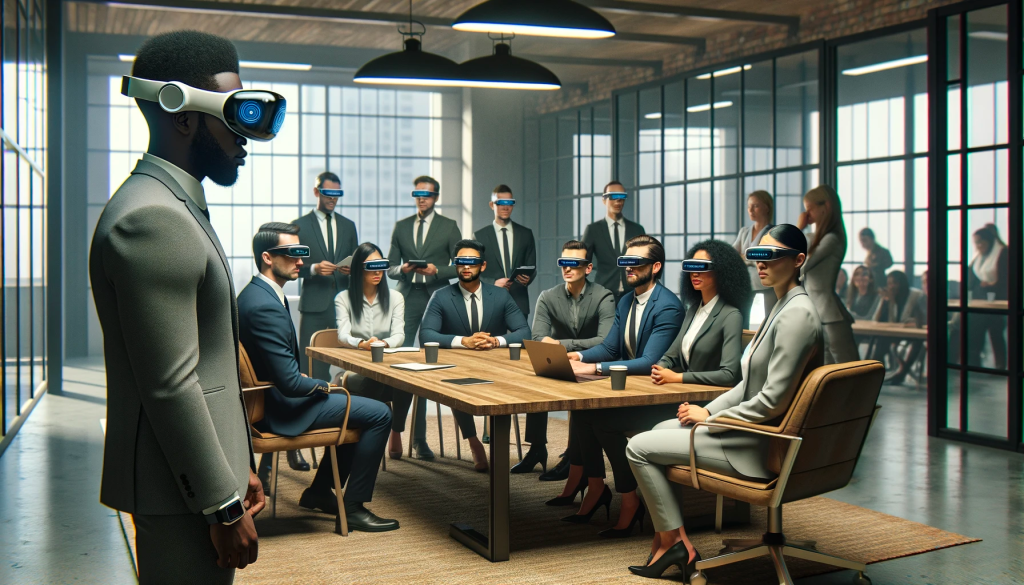
Establishing Empathy With the Emotions of Workers Will Help Us Serve Them — and Us — Better
By 2030, we can expect emo-surveillance to morph into a sophisticated, ethical tool for building truly supportive and responsive workplaces. Imagine offices dynamically adjusting lighting and temperature based on the collective mood, or AI-powered assistants offering confidential emotional support when stress levels rise. While concerns about privacy must be addressed head-on, the potential for emo-surveillance to cultivate a workforce that feels seen, heard, and understood is undeniable. In a world where human connection is paramount, technology can become a bridge, helping businesses not just listen to their employees, but truly feel alongside them. This is the future of empathetic leadership, and it promises to usher in a new era of employee well-being and corporate responsibility.
Simplicity Maximization
This new work practice emerges as the critical counterbalance to the escalating challenge of managing technological complexity in large enterprises. As organizations continue to adopt an ever-growing array of technologies, the need to simplify and streamline tech usage becomes paramount. Simplicity maximization focuses on decluttering the technological landscape, ensuring that the tools and systems in place are intuitive, integrated, and aligned with the actual needs of the business. This approach not only enhances the user experience but also drives higher adoption rates of essential technology solutions. By reducing complexity, organizations can more effectively implement and benefit from automation, making it a practical and integral part of their operations. Simplification efforts extend to every aspect of technology use, from the user interface design of software applications to the architecture of enterprise systems, ensuring that technology serves as an enabler rather than a hindrance.

By the end of the decade, simplicity maximization is anticipated to evolve into a rigorous and formal discipline within many organizations, underpinned by the increasingly popular corporate practice of value maximization. This evolution will see simplicity being treated not just as a design principle but as a strategic imperative, driving decision-making and investments in technology. Companies will adopt systematic approaches to evaluate and streamline their tech stacks, focusing on eliminating redundancies, integrating systems, and fostering an environment of continuous improvement. The discipline of simplicity maximization will also emphasize the importance of aligning technology with business objectives, ensuring that every tool, platform, or system contributes directly to the organization’s value creation efforts. This deliberate and structured approach to managing technology will empower organizations to navigate the complexities of the digital age — a trend I have been tracking for a half decade now — more effectively, turning the promise of technological advancement into tangible business outcomes.
Hyper-Local, On-Demand Maker Economy
The convergence of escalating supply chain disruptions and mounting global conflict is catalyzing the emergence of a hyperlocal, on-demand maker economy. This trend represents a paradigm shift from the traditional, centralized manufacturing model to a more distributed and responsive approach. Driven by advancements in 3D printing and additive manufacturing technologies, including advanced multi-material printers, businesses are increasingly able to manufacture a wide array of items on-site, tailored to their specific needs. This capability is not only transforming how businesses manage facility repairs and maintenance, reducing downtime and dependency on external suppliers, but it’s also enabling the production of locally sourced products, aligning with growing consumer demand for sustainability and localism. Moreover, sectors such as healthcare are witnessing revolutionary changes, with on-demand manufacturing allowing for the rapid production of customized medical devices and prosthetics, directly in hospitals or clinics, significantly improving patient care.

Supply Chains Become More Local, On-Demand, 1:1 Customized To Deal with Global Challenges
Looking ahead to 2030, the on-demand maker economy is poised to become a fundamental aspect of the business landscape, driven by continuous technological innovations in 3D printing and additive manufacturing. As these technologies become more sophisticated, offering higher precision, faster production times, and a broader range of materials, their adoption will extend to an even wider array of industries. For instance, the construction sector could see a surge in the use of on-site printed materials, revolutionizing building processes and design possibilities. Similarly, the automotive and aerospace industries might leverage on-demand manufacturing for the production of customized, lightweight components, leading to more efficient and environmentally friendly vehicles. This shift towards a hyperlocal, on-demand maker economy not only promises to enhance operational efficiency and product customization but also contributes to a more resilient and sustainable global economy, characterized by reduced logistics dependencies and lower carbon footprints.
Everyone As Citizen Developer
The concept of the ‘citizen developer’ is set to become a universal reality by 2030, marking a significant democratization of digital transformation within organizations. This shift is propelled by the evolution from enterprise-grade low-code platforms like Appian to fully no-code environments, enabled by the advent of comprehensive end-to-end AI app generation and maintenance. In this new era, the ability to create and deploy IT solutions will no longer be confined to IT professionals. Instead, individuals across various departments will have the power to develop the applications they need to address their specific business challenges, all with minimal technical expertise. This revolutionary change is driven by intuitive no-code platforms that allow users to build applications through simple visual interfaces or by describing their requirements in natural language. The result is a significant acceleration in innovation and operational efficiency, as employees are empowered to create tailored solutions swiftly, without the traditional bottlenecks of IT development processes.

In the Very Near Future, Everyone Will Use AI to Create All the Apps They Want
One notable example of a firm embracing this trend is Siemens, which has integrated low-code and no-code platforms into its core business operations. Siemens has leveraged these platforms to enable its non-technical staff to build custom applications that address specific operational needs, ranging from project management solutions to customer engagement tools. This approach has not only streamlined their workflows but also fostered a culture of innovation and agility. By allowing employees who are closest to the business challenges to create their solutions, Siemens has effectively tapped into a vast reservoir of creativity and domain-specific knowledge. As we approach 2030, this model is expected to become increasingly prevalent, with businesses across various industries adopting no-code platforms to unleash the full potential of their workforce, turning every employee into a citizen developer and every department into a hub of digital innovation.
AI Work Concierges
The emergence of AI work concierges will transform the modern workplace, acting as highly assistive agents that significantly enhance productivity and job satisfaction. These AI-powered concierges are designed to handle a multitude of rote and administrative tasks, freeing up employees to focus on more complex and creative aspects of their work. From scheduling meetings and managing emails to providing real-time data analysis and generating reports, these AI assistants can perform a broad range of functions. More impressively, they are increasingly capable of offering just-in-time assistance, often proactively identifying needs based on patterns in worker behavior and preferences. This level of support is akin to having a virtual team dedicated to optimizing each worker’s performance, ensuring that every task is handled efficiently and every opportunity for improvement is seized.

Within a half-decade, AI work concierges are expected to become an indispensable part of the workforce, akin to a virtual co-worker or team that collaborates seamlessly with human employees. As AI technology evolves, these concierges will likely become more intuitive and adaptive, capable of predicting needs and personalizing support in increasingly sophisticated ways. For example, an AI concierge might automatically reschedule meetings if it detects a potential conflict or suggests breaks and wellness activities based on an analysis of the worker’s schedule and stress levels. Companies like IBM and Google are already pioneering this space, with AI assistants that can understand and execute complex commands, interact through natural language, and learn from their interactions to provide better support over time. As we head towards 2030, AI work concierges are set to become a ubiquitous feature in the workplace, driving a significant shift in how work is organized and executed, and redefining the concept of teamwork to include both human and AI collaborators.
Digital Counseling
The growing use of digital counseling in the workplace marks a significant stride towards fostering a supportive and empowering work environment. As organizations increasingly acknowledge the holistic well-being of their employees, digital counseling emerges as a crucial tool to help workers unlock their potential, productivity, and fulfillment. This form of counseling extends beyond traditional career guidance or personal challenge support; it offers a nuanced, comprehensive approach to addressing a wide array of professional dilemmas and aspirations. Workers can receive tailored advice on navigating complex project dynamics, enhancing leadership skills, or balancing work-life pressures. The business benefits of this trend are substantial. By investing in the well-being and development of their employees, organizations witness improved morale, lower turnover rates, and a more engaged, innovative workforce. Employees feel valued and understood, translating into a more committed and productive approach to their roles.

By this decade’s end, digital counseling is anticipated to become an integral component of the resilience regime of modern organizations, largely driven by AI’s evolution. AI in digital counseling will deliver hyper-personalized, empathetic support on a 1:1 basis, ensuring that each worker’s unique context and needs are addressed. These AI systems will be equipped to analyze vast amounts of data, including work patterns, feedback, and even biometric indicators, to provide insights and recommendations that are deeply aligned with each employee’s professional journey and personal well-being. This level of customization ensures that the support is not just generic advice but a meaningful, actionable guidance that resonates with the individual’s specific situation, be it a challenging business scenario or a personal growth opportunity. As AI technologies continue to mature, their capability to understand and mimic human empathy and judgment will significantly enhance the efficacy of digital counseling, making it a cornerstone of organizational support systems, driving a workforce that is not only proficient but also resilient and fulfilled.
The Trust Economy
As we move into a era of digital uncertainty, the Trust Economy is poised to become a cornerstone of digital interaction and commerce, a direct response to the increasing prevalence of misinformation, cyberattacks, and privacy breaches. In this emerging paradigm, trust is not just a value but a tangible asset, underpinned by advanced technologies designed to secure, validate, and streamline every digital interaction. Decentralized control systems like blockchain form the backbone of this economy, ensuring transparency and immutability of data, making it virtually impossible to alter or forge information. Alternative digital currencies are gaining traction, offering secure and decentralized financial transactions. Digital signatures and biometric security systems are becoming ubiquitous, providing robust authentication mechanisms that are unique to each individual. Furthermore, the widespread adoption of heavy end-to-end encryption ensures that data, whether in transit or at rest, is accessible only to the intended parties. These trust technologies collectively create a secure digital ecosystem where every transaction, whether financial, informational, or communicational, continually proves its worthiness and integrity.

Technology That Is Inherently Trustworthy by Design Will Be Increasingly Relevant in Business
As we near the end of the decade, the Trust Economy is expected to evolve into an integral framework within which all digital transactions occur. It’s not merely about preventing fraud or protecting data; it’s about building an environment where the digital aspect of our lives is inherently secure, reliable, and private. In this economy, businesses that prioritize and invest in trust technologies will thrive, as consumers and partners gravitate towards entities that can demonstrably safeguard their interests. The widespread implementation of trust technologies will also catalyze new business models and opportunities, particularly in sectors like fintech, e-commerce, and data services. As we embrace this new era, the Trust Economy will likely reshape not just how we conduct business but also how we perceive and value digital interactions, making trust a fundamental, quantifiable asset in the digital age.
Related Research: The Future of Money: Digital Assets in the Cloud
The 1:1 Personalized Employee Experience
By 2030, the personalized employee experience is set to reach an unprecedented level of customization and sophistication, representing a paradigm shift in workplace dynamics. This transformation is underpinned by the convergence of several cutting-edge trends explored abovce, including universal work portals, AI work concierges, emo-surveillance, and the citizen developer movement. The universal work portal will serve as the central hub for each employee’s work life, offering a tailored interface that adapts to individual work styles and preferences. AI work concierges will provide on-demand, personalized support, handling routine tasks and offering insights to optimize productivity and well-being. Emo-surveillance will play a crucial role in this ecosystem, continuously gauging employee sentiment and stress levels, ensuring that the work environment remains supportive and responsive to individual emotional needs. Furthermore, the citizen developer trend will empower employees to create and customize their digital tools, ensuring that the technology they use is perfectly aligned with their unique work processes.

Many of Us Will Design the Employee Experiences of Our Dreams by 2030
The culmination of these trends will lead to the co-creation of a 1:1 personalized employee experience, designed specifically for each individual worker. This bespoke approach will revolutionize the concept of employee engagement and job satisfaction. Work will no longer be a one-size-fits-all affair; instead, every aspect of an employee’s professional journey – from the tools they use to the way they receive support and feedback – will be finely tuned to match their personal preferences, strengths, and career aspirations. This level of personalization will not only boost productivity and creativity but also foster a deeper sense of belonging and fulfillment among employees. Organizations that embrace and invest in creating these personalized experiences will not only attract and retain top talent but also cultivate a culture of innovation and resilience, ready to thrive in the ever-evolving landscape of the modern workplace.
Hyper-Real Personal Avatars and Digital Twins
As we advance towards 2030, the concept of hyper-real avatars is set to redefine the boundaries of personal digital representation and interaction in the workplace. These avatars, transcending mere visual mimicry, will encapsulate the full spectrum of an individual’s personality, knowledge, and behavioral nuances, essentially becoming comprehensive digital twins of their human counterparts. Enabled by breakthroughs in AI, machine learning, and graphical modeling, these avatars will offer an unprecedented level of realism and cognitive capabilities. They will not just represent individuals in digital spaces but will actively participate in work processes, engaging in meetings, making decisions based on predefined criteria, and even undertaking complex tasks. This will allow human workers to delegate routine or time-consuming activities to their digital twins, freeing up time for more strategic, creative, or complex problem-solving tasks. The digital twin will essentially act as an extension of the individual, capable of continuous operation, thereby transcending the limitations of time zones and work schedules.

Within a few years, these hyper-real avatars will become a fundamental component of the professional ecosystem, revolutionizing the concept of work and productivity. As these digital twins become more sophisticated, they will be able to learn and adapt over time, refining their decision-making and interaction based on continuous feedback and new experiences. This will enable a symbiotic relationship between humans and their digital counterparts, with avatars handling an increasing share of professional responsibilities. They will attend meetings, engage in negotiations, and even carry out complex analytical tasks, ensuring that human workers are kept up-to-date and seamlessly integrated with the work done by their digital twins. This trend will not only transform individual productivity but also redefine team dynamics, project management, and business operations, paving the way for a future where the fusion of human and digital capabilities sets a new standard for efficiency, innovation, and workplace flexibility.
ResilienceOps
This emerging practice represents a forward-thinking paradigm that embeds digital resilience into the very fabric of business operations and work, mirroring the principles of DevOps with an emphasis on agility, continuous improvement, and proactive risk management. As organizations navigate an increasingly volatile business landscape characterized by rapid technological changes, cybersecurity threats, and supply chain vulnerabilities, ResilienceOps emerges as a strategic imperative. This approach integrates resilience into every phase of the business cycle, from planning and development to deployment and operations. It involves continuous monitoring, real-time risk assessment, and agile response mechanisms to ensure that businesses can quickly adapt and recover from disruptions. By fostering a culture of resilience, organizations not only safeguard their operations but also seize opportunities to innovate and grow in the face of adversity. ResilienceOps entails a holistic view of the organizational ecosystem, ensuring that resilience is not siloed but is a collective responsibility, embraced across departments and disciplines.

By 2030, ResilienceOps is expected to evolve into a core business function, underpinned by a nascent but increasingly robust cottage industry of support tools and services. These tools will leverage advanced technologies such as AI, machine learning, and predictive analytics to provide sophisticated risk assessment, scenario planning, and decision support capabilities. They will enable organizations to simulate potential disruptions, model their impacts, and devise optimized response strategies. Furthermore, the integration of blockchain and distributed ledger technologies will enhance transparency and traceability in supply chains, bolstering resilience against disruptions. As ResilienceOps matures, it will drive a shift from reactive crisis management to proactive resilience building, empowering organizations to not just withstand shocks but to adapt and thrive amidst them. The cottage industry supporting ResilienceOps will see rapid growth, offering a wide array of solutions ranging from resilience consulting services to specialized software platforms like the popular Fusion Framework System, becoming an indispensable part of the business ecosystem by 2030.
The Omniscient Organization
The concept of an ‘all-knowing organization’ is rapidly taking shape, spurred by the digital transformation of business processes and their pervasive generation of ‘digital exhaust’, the data trail left by digitized business activities. As every facet of business becomes digitized, the vast universe of corporate data, coupled with external data sources, is now being assimilated into large language models (LLMs). These advanced AI-driven systems are enabling workers to access an unprecedented depth and breadth of organizational knowledge. This access isn’t just about retrieving information. It’s about understanding patterns, making connections, and deriving insights that were previously obscured by the sheer volume and complexity of the data, and often gate-kept by workers in the hierarchy. Workers can now pose complex queries and receive comprehensive, contextually relevant insights, effectively having the total sum of digital knowledge within the organization at their fingertips. This transformation is eliminating traditional barriers to information and insight, empowering employees at all levels to make informed, data-driven decisions. Platforms like Sinequa and Practicus AI.

As we head deeper into the cognitive era, the democratization of insight afforded by the omniscient organization is poised to fundamentally transform how businesses operate. The widespread access to comprehensive, AI-powered analysis will flatten organizational hierarchies, as decision-making becomes more distributed and data-driven. Employees will be able to leverage the collective intelligence of the organization to innovate, solve problems, and adapt to changes with unprecedented agility. This will not only accelerate the pace of innovation but also foster a more collaborative and engaged workforce, as employees are empowered to contribute meaningfully based on the insights they derive. Furthermore, the ability of these systems to continuously learn and evolve will ensure that the insights they provide remain relevant and actionable, driving a continuous cycle of learning, improvement, and growth. The rise of the omniscient organization represents a quantum leap in the evolution of the workplace, turning the vast ocean of digital data into a powerful engine of insight, innovation, and empowerment.
Perfect Onboarding
The process of new employee onboarding, traditionally fraught with challenges and complexities, is poised for a transformative leap through the integration of digital experience technologies. The concept of ‘perfect onboarding’ is becoming a reality, characterized by seamless integration of various support tools and activities designed to make the transition smooth and engaging for new hires. This includes an array of digital resources like comprehensive e-learning modules, interactive videos, online signing of work documents, and virtual introductions to teammates through chat channels. The journey begins even before the official start date, with pre-boarding activities that familiarize the new employee with the company culture, expectations, and their specific role. Post-hire, the onboarding process continues to unfold, encompassing a wide spectrum of systems and activities essential for a well-rounded integration into the organization. The aim is to ensure that every new hire feels welcomed, well-informed, and prepared to contribute from day one.
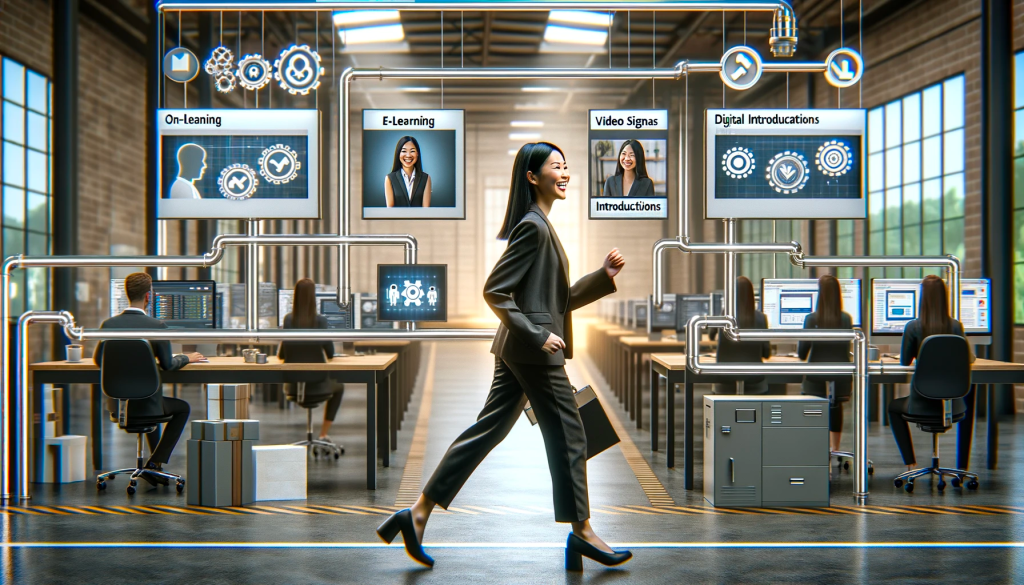
By leveraging AI, the orchestration of the onboarding process transcends to a level of sophistication and personalization previously unattainable. AI systems are capable of guiding new hires through each step of the process, providing just-in-time information, answering queries, and even soliciting and acting on feedback to continuously improve the onboarding experience. This intelligent orchestration ensures that the process is not just easy, but also fulfilling, exciting, and genuinely useful, setting the tone for a positive and productive tenure at the company. As we look towards the future, the role of AI in onboarding is expected to become even more integral, with predictive analytics offering insights to tailor the experience to individual needs and preferences. By 2030, digital onboarding will likely be an immersive, interactive journey, with virtual reality tours, AI mentors, and personalized learning paths becoming standard practices, reflecting a profound shift in how organizations welcome and integrate their most valuable asset – their people. Examples of next-generation include On Board by HR Cloud and Click Boarding.
DevOps for Business
As we approach 2030, the evolution of DevOps into a more encompassing operational and business paradigm signifies a transformative shift in organizational structures and processes. This expansion of DevOps, often referred to as BizDevOps, extends the principles of collaboration, automation, and rapid iteration beyond the realms of development and IT operations, to include all operational domains and business functions. This trend is driven by the realization that the agility, efficiency, and innovation fostered by DevOps in software development and IT operations can yield similar benefits when applied across the entire organization. By integrating business units into the DevOps loop, organizations ensure that product development, security considerations, and business strategies are seamlessly aligned and mutually reinforcing. This holistic approach leads to more coherent product offerings, faster go-to-market times, and a more resilient business model that can adapt swiftly to changing market dynamics.
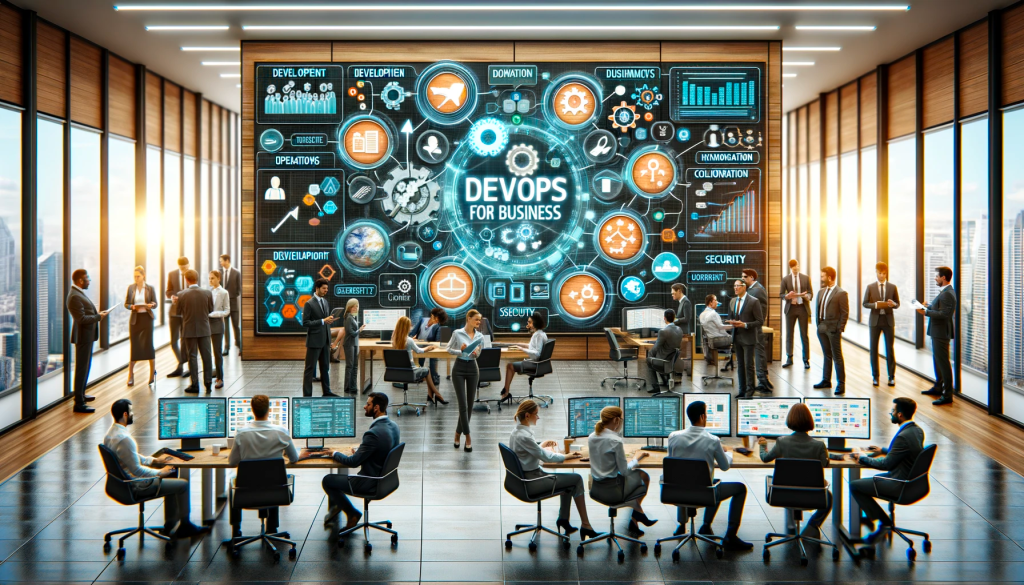
The implications of this trend are profound, marking a departure from traditional siloed business operations to a more integrated and responsive framework. One of the primary advantages of this expanded DevOps approach is the unprecedented integration of IT and business, ensuring that technology initiatives are closely aligned with business goals and market needs. This alignment is crucial in an era where digital transformation is a key competitive differentiator. Furthermore, by fostering a culture of continuous feedback and iterative improvement across all business functions, organizations can enhance their responsiveness to customer needs, improve operational efficiency, and foster a culture of innovation. The expansion of DevOps principles across the business landscape is not just a trend; it’s a paradigm shift that promises to redefine the very fabric of how organizations operate and compete in the digital age. By 2030, this integrated approach is likely to be the standard, with the most successful organizations being those that have fully embraced and adeptly implemented this comprehensive, collaborative, and agile operational model.
Management by AI
As we progress further into the digital age, the management of organizations by AI is becoming not just a possibility, but an increasingly prevalent reality. AI’s capabilities in data analysis, pattern recognition, and decision-making are being harnessed to revolutionize management practices. These systems can process vast quantities of data in real-time, providing insights and recommendations that would be impossible for human managers to generate at the same speed or scale. From optimizing resource allocation to predicting market trends and personalizing employee experiences, AI’s potential to enhance and streamline organizational management is vast. Moreover, AI systems can work 24/7, making them invaluable assets in our increasingly global and always-on business environment. They can monitor operations continuously, identify issues or opportunities the moment they arise, and even implement solutions autonomously, guided by predefined business rules and objectives.

Yes, Sometimes the Bots Will Be In Charge. Hopefully Only When We Don’t Want To Be
By 2030, AI’s role in organizational management is expected to have expanded significantly. These systems will not only be tasked with routine management operations but also with more complex strategic decision-making processes. Advances in machine learning and natural language processing will enable AI systems to understand and interact in human language, allowing for more intuitive and natural communication with team members. Additionally, as AI systems become more autonomous and capable of learning and adapting, they will be entrusted with broader responsibilities, potentially leading entire projects or departments. This transition will require a paradigm shift in how we perceive leadership and decision-making in a corporate context. While human intuition and creativity will remain crucial, the integration of AI into management will bring about a more data-driven, efficient, and potentially more objective approach to running organizations, ultimately reshaping the traditional hierarchy and operations of businesses.
Spatial Computing as Primary User Interface
Within the next six years, spatial computing is poised to revolutionize user interaction paradigms, establishing itself as the primary user interface and fundamentally altering our digital interactions. The advent of the Apple Vision Pro is expected to be a pivotal moment in this transformation, propelling hybrid AR/VR technology into the mainstream. This device is projected to address and overcome many of the limitations that have historically hindered the adoption of spatial computing systems, such as cumbersome hardware, an isolating experience, and lack of intuitive user interfaces. By resolving these issues, the Apple Vision Pro will unlock the full potential of immersive environments, where an extensive array of visual information can be intricately presented, thoroughly consumed, and dynamically interacted with. This capability will extend beyond mere data visualization to include complex, multi-dimensional scenarios, significantly enhancing the richness and depth of digital experiences.

The implications of widespread spatial computing are particularly profound in the realms of operations and management. For instance, global teams could conduct meetings within virtual spaces that not only mimic physical conference rooms but also allow for the manipulation and analysis of 3D data models in real-time, fostering a level of collaboration that transcends geographical constraints. In the field of data analysis and decision-making, managers could navigate and interact with complex data landscapes as if they were physical entities, gaining insights that are both intuitively understood and intricately detailed. Moreover, training and development programs could leverage realistic simulations, enabling employees to hone their skills in environments that accurately replicate real-world scenarios, yet are entirely safe and controllable. By integrating spatial computing into these aspects of business operations, organizations will not only enhance efficiency and productivity but also foster a more engaged and empowered workforce, ready to thrive in the increasingly complex digital landscape of 2030.
Radical Flexibility
As we navigate through an era marked by rapid technological advancements and external disruptions, such as supply chain failures and global conflicts, the concept of radical flexibility is emerging as a new paradigm for organizational survival and success. This approach goes beyond traditional flexible work policies, encompassing a holistic strategy that enables organizations to swiftly adapt to changing circumstances. Radical flexibility involves reimagining work processes, organizational structures, and even business models to be inherently adaptable and responsive. It’s about creating an environment where change is not just anticipated but seamlessly integrated into the fabric of the organization. This extreme nature of adaptability is facilitated by innovative tools like low/no-code platforms and AI, which empower individuals across the organization to develop solutions, automate processes, and analyze data without being constrained by technical limitations or traditional hierarchies.
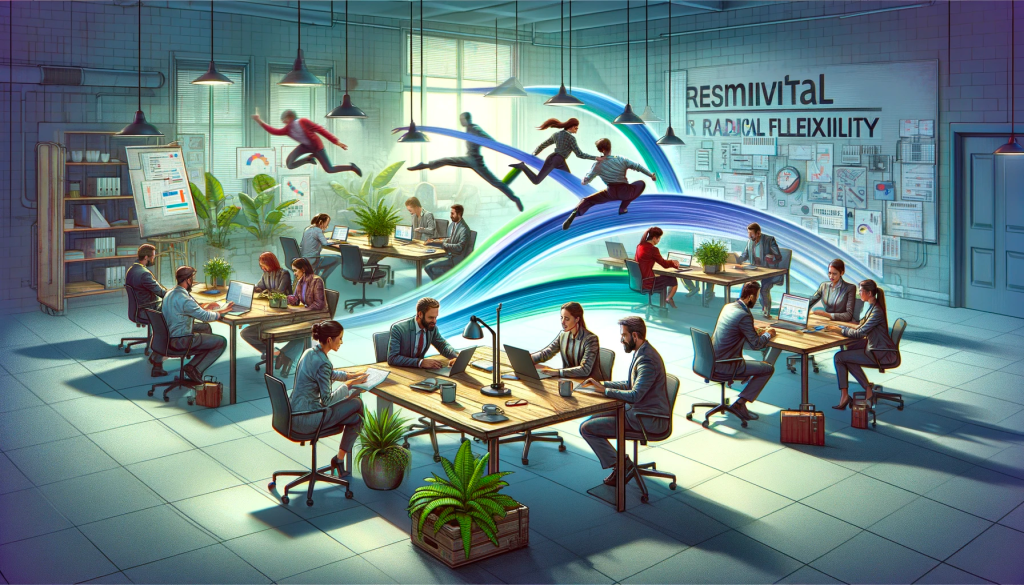
By 2030, radical flexibility is likely to have become the norm for successful organizations, driven by the continuous evolution of enabling technologies. Low/no-code platforms will democratize application development, allowing employees to swiftly create and deploy solutions in response to emerging needs or opportunities. AI will further enhance this adaptability, providing real-time insights, predicting trends, and automating complex decision-making processes. The convergence of these technologies will enable organizations to not just react to changes but proactively shape their future, turning adaptability into a competitive advantage. In this landscape, the agility to innovate, the capacity to pivot, and the ability to harness the collective potential of the workforce will be the key differentiators for organizations. Radical flexibility will redefine resilience, transforming it from a defensive posture to a dynamic, forward-leaning approach that leverages the full spectrum of technological and human capabilities.
The Fully Automated Workforce
As we progress towards a future marked by rapid technological advancements, the concept of a fully automated workforce is becoming an increasingly tangible reality. The relentless march of automation is expected to engulf all rote and repetitive tasks, effectively relegating them to sophisticated AI systems and humanoid robots like Tesla’s Optimus. This paradigm shift is set to redefine the very nature of work, particularly for knowledge workers. In this new era, the human workforce will pivot away from operational duties to focus primarily on areas where human insight and creativity are paramount: strategy and governance. The typical knowledge worker’s day will no longer be bogged down by mundane tasks. Instead, their expertise will be leveraged in crafting innovative strategies, overseeing complex projects, and ensuring that the AI and robotic workforce adhere to ethical standards and align with organizational goals. Human workers will become the architects and custodians of a digital ecosystem where operations, product development, and delivery are executed with precision by an army of AI-driven bots and robots.

By entrusting the execution of routine tasks to automated entities, organizations will unlock unprecedented levels of efficiency and productivity. This will not only accelerate the pace of innovation but also free up human talent to tackle more complex, creative, and meaningful challenges. The symbiosis between human intellect and robotic efficiency will pave the way for groundbreaking advancements in every sector. In manufacturing, for instance, humanoid robots like Optimus could undertake the entire production process, from assembly to quality control, while human workers focus on design, innovation, and process optimization. Similarly, in the service sector, AI-driven systems could manage everything from scheduling to customer service, allowing human employees to concentrate on improving the customer experience and expanding the business. This vision of a fully automated workforce, steered by strategic and governance-focused human professionals, represents a bold leap into a future where the potential of both human and artificial intelligence is fully realized, driving society towards new heights of prosperity and progress.
Quantum-Supercharged Organizations
The advent of quantum computing promises to usher in a transformative era for organizations, particularly for those early adopters who are poised to leap ahead of the competition. Unlike traditional computing, quantum computing harnesses the peculiar principles of quantum mechanics to process information at speeds and levels of complexity previously deemed unattainable. This monumental shift in computational power will open up radical new windows of opportunity, enabling organizations to solve intricate problems, analyze massive datasets, and innovate at an unprecedented pace. Early adopters of quantum solutions stand to gain a formidable competitive edge, as they will be equipped to tackle challenges and seize opportunities that are beyond the reach of conventional computational methods. For instance, in fields like drug discovery, material science, and financial modeling, the ability of quantum computing to navigate vast solution spaces and identify optimal outcomes could drastically shorten research and development cycles, reduce costs, and foster groundbreaking innovations.

When we reach 2030, the impact of quantum computing on organizational capabilities is expected to be profound, especially for those who have strategically embraced this technology early on. Quantum computing will not only supercharge problem-solving and decision-making processes but also redefine the boundaries of what is possible. Organizations that harness the power of quantum computing will be able to perform complex simulations in a fraction of the time it takes today, decrypt and secure information with unprecedented levels of security, and optimize large-scale systems and operations with unparalleled efficiency. The ripple effects of these capabilities will be vast, driving a wave of transformation across industries and reshaping the competitive landscape. As quantum technology continues to mature and become more accessible, its integration into business operations will transition from a strategic advantage to an operational necessity. The organizations that recognize and invest in the potential of quantum computing today will not only be the pioneers of this revolutionary technology but also the architects of the future business paradigm.
CSR as Primary Objective
By 2030, the paradigm of corporate success is set to undergo a profound transformation, with an increasing number of enlightened organizations placing corporate social responsibility (CSR) at the forefront of their business objectives. This shift reflects a deep understanding that long-term business sustainability is intrinsically linked to social and environmental stewardship. These forward-thinking organizations are not just passively responding to market demands for greater responsibility; they are actively redefining their purpose to contribute positively to society and the planet. This commitment to CSR resonates deeply with the values and aspirations of Generation Z and Generation Alpha, cohorts known for their strong sense of social justice and environmental concern. For these generations, the notion of success extends beyond the traditional metrics of profitability to include the impact an organization has on the world. They are drawn to mission-oriented organizations that align with their desire to address and mitigate global challenges such as climate change, inequality, and social injustice. The allure of contributing to a meaningful, larger cause is a powerful motivator for these individuals, influencing their decisions as consumers, employees, and future leaders.

As we reach 2030, the trend of aligning business objectives with CSR goals is likely to become a defining characteristic of the most successful and respected organizations. These entities will not only attract the most passionate and purpose-driven talent from Generation Z and Alpha but will also cultivate a loyal customer base that values ethical and sustainable practices. The convergence of advanced technology, innovative business models, and a culture of empathy and collaboration will enable these organizations to tackle complex societal challenges effectively. This evolution marks a pivotal shift in the corporate landscape, where profit and purpose are not seen as mutually exclusive but as mutually reinforcing. The rise of mission-oriented organizations heralds a new era of business, one where the ultimate measure of success is the positive impact made on the world, appealing to the altruistic spirit of younger generations and setting a new standard for what it means to be truly successful in the modern age.
Frictionless Biosecurity
By 2030, the landscape of cybersecurity and personal identity verification is poised to undergo a revolutionary transformation, driven by the advent and integration of seamless next-gen biosecurity technologies. Traditional authentication methods like passwords, which are often vulnerable to breaches and theft, are being replaced by easier methods like advanced biosecurity measures that offer a more robust and foolproof means of establishing and safeguarding digital identity. Technologies such as eye scans, brain scans, and real-time DNA recognition are at the forefront of this transformation. These biometric systems leverage unique biological characteristics that are inherently difficult to replicate or forge, ensuring a higher level of security. For instance, eye scans can analyze intricate patterns in the iris, while brain scans might assess specific neural response patterns, and DNA recognition technologies can rapidly validate an individual’s genetic code. The integration of these technologies into digital systems provides a secure and seamless method of identity verification, significantly reducing the risk of unauthorized access and cyber threats.

The shift from traditional passwords to biosecurity technologies is set to redefine not just the security landscape but also the overall user experience in digital workplaces. Secure proof of identity through biosecurity measures streamlines the authentication process, eliminating the need for remembering complex passwords or undergoing cumbersome multi-step verification processes. This transition not only fortifies the security infrastructure of organizations but also enhances usability and efficiency, contributing to a more trusted and productive digital work environment. As these technologies become more sophisticated and accessible, they are likely to become an integral part of daily digital interactions, offering a seamless blend of security and convenience. This evolution in cybersecurity and personal identity verification marks a significant stride towards a future where digital systems are not only more secure but also more intuitive and user-friendly, aligning with the fast-paced, security-conscious ethos of the modern digital workplace.
Work/Life Podcoons
The concept of ‘work/life podcoons’ represents a groundbreaking shift in how businesses approach employee well-being and satisfaction. These podcoons are specially designed, digitally-enabled environments that seamlessly integrate work and life, offering a balanced space where employees can thrive both professionally and personally. The core philosophy behind podcoons is to provide a holistic environment that caters to the total fulfillment of the employee, encompassing not just their work needs but also their lifestyle preferences and well-being. These sophisticated spaces are equipped with advanced technology, comfortable living amenities, and flexible workstations, allowing employees to effortlessly switch between work and personal life while maintaining a healthy separation when needed. The appeal of podcoons lies in their ability to offer a sanctuary that supports productivity, creativity, and relaxation in equal measure, addressing the growing desire among employees for workplaces that acknowledge and support their life beyond the office walls.

For a generation of workers who value the integration of support and convenience in their lives, the rise of podcoons represents a significant evolution in employee benefits. This generation, accustomed to a more parental and nurturing approach in various aspects of their lives, finds the concept of podcoons particularly appealing. It aligns with their expectations for an employer that takes a vested interest in their overall well-being and personal growth. The benefits of podcoons extend beyond individual employee satisfaction; they foster a sense of loyalty, belonging, and engagement, leading to higher retention rates and attracting top talent who are seeking more than just a job but a lifestyle. As businesses continue to navigate the challenges of the modern workforce, the adoption of work/life podcoons stands as a testament to an organization’s commitment to embracing a more comprehensive, nurturing, and human-centric approach to employee well-being.
Holographic Workplace
The holographic workplace represents a groundbreaking evolution in how we perceive and interact with our work environments. By leveraging advanced holographic and augmented reality technologies, this virtual 3D holodeck creates an office or factory space that feels as real and tangible as its physical counterpart. However, it offers far more than mere replication. The holographic workplace is capable of instant augmentation and integration with a multitude of data sources, providing real-time data visualization, volumetric quantitative displays, and a myriad of other interactive overlays and information panels. This immersive environment enables workers to interact with complex data and systems in a more intuitive and natural way, breaking free from the constraints of traditional two-dimensional screens and interfaces. The ability to manipulate and analyze data in a three-dimensional space not only enhances understanding and decision-making but also opens up new possibilities for creativity and innovation.

By 2030, the holographic workplace is anticipated to redefine the concept of spatial efficiency and productivity. The integration of these advanced display technologies will enable some workers to function effectively in four-dimensional spatial environments, navigating through time and space with unprecedented precision and insight. This shift will be particularly transformative in industries where spatial awareness and data interaction are critical, such as architecture, engineering, and manufacturing. The holographic workplace will not only facilitate a more immersive and interactive way of working but also foster a more dynamic and adaptable workforce, capable of understanding and responding to complex scenarios with enhanced agility. As these technologies continue to evolve and become more integrated into our daily work lives, the holographic workplace will set a new standard for how we visualize, interact with, and derive insights from the world around us, ushering in an era of heightened efficiency, creativity, and innovation in the professional sphere.
Humanoid Worker Robots
Humanoid robots like Tesla Optimus represent a groundbreaking evolution in the landscape of work and productivity, signaling a future where the boundaries of physical labor capacity are dramatically expanded. These robots, designed to perform a wide array of tasks traditionally done by humans, are poised to revolutionize automation in environments built for human bodies. As cost-effective physical assistants, they can handle repetitive, dangerous, or intricate tasks, reducing the risk of injury and freeing human workers to focus on more complex, creative, and decision-making roles. The potential of humanoid robots extends beyond mere assistance. They are also envisioned as colleagues working alongside humans, complementing their skills and contributing to a more dynamic and capable workforce. The integration of advanced AI and learning algorithms enables these robots to adapt and improve over time, making them increasingly valuable assets in various industries. The proliferation of humanoid robots is set to create an ‘unlimited economy,’ where the constraints on physical labor are almost completely eliminated, opening new horizons for productivity, innovation, and growth.

However, this transformative shift is not without its challenges, particularly in the short term. The introduction of humanoid robots into mainstream industries is likely to disrupt traditional labor markets, raising concerns about job displacement and the need for workforce reskilling. As these robots take over tasks previously performed by humans, there will be a pressing need to manage the transition, ensuring that the workforce is prepared for a future where human-robot collaboration is the norm. This entails not only providing training and education to develop new skills but also rethinking the social and economic structures to support those impacted by the changes. The key to harnessing the full potential of humanoid robots like Tesla Optimus lies in striking a balance between technological advancement and social adaptability, creating a future where automation and human talent together drive unprecedented levels of productivity and innovation.
Leisure Life
This increasingly significant trend represents a radical departure from traditional notions of work and lifestyle, embracing a paradigm where personal passion, creativity, and expression form the cornerstone of value creation. This extreme version of semi-commercial living sees individuals engaging in a plethora of activities such as sports, dance, maker activities, artisanal farming, or adopting an influencer-style life. These pursuits, while seemingly leisurely and unrelated to conventional job roles, actually generate substantial value. Individuals living this lifestyle are not bound by the typical 9-to-5 structure but are deeply immersed in activities that resonate with their innermost passions and talents. The monetization of this lifestyle is as unconventional as the activities themselves, often relying on corporate sponsorships, crowdfunded patronage, merchandise sales, or a blend of these with supplemental income streams like a universal basic income thrown off by mass global hyperautomation. The financial model not only supports the individuals engaged in these activities but also creates a symbiotic relationship with the businesses and brands that sponsor or collaborate with them, leveraging their influence and community engagement.

By blurring the lines between work and leisure, the Leisure Life concept taps into the most passionate and creative instincts of individuals, fostering an environment where the pursuit of personal interests directly translates into value creation. This lifestyle reshapes the traditional workforce landscape, introducing a new dimension where personal fulfillment and professional value coexist harmoniously. Businesses and brands that align with these lifestyle practitioners benefit from authentic, passionate representations of their products or services, reaching audiences in a more organic and impactful manner. As we move forward, this concept is poised to redefine the metrics of success and productivity, placing individual well-being, creativity, and authentic expression at the forefront of value generation in an increasingly diverse and dynamic socio-economic landscape.
Autonomous Organizations
The trajectory of hyperautomation is leading us towards the concept of autonomous organizations, a future where businesses are predominantly operated by sophisticated code and AI systems, minimizing the need for human intervention. These autonomous organizations are constructed from proven templates, providing a comprehensive operational framework encompassing marketing, sales, operations, and customer service. The crux of this model lies in its ability to rapidly materialize an idea into a fully functioning business, leveraging digital ecosystems and operational infrastructures like Decentralized Autonomous Organizations (DAOs). In these entities, human involvement is largely confined to oversight roles and occasional problem diagnosis, with AI increasingly capable of handling even these complex tasks. The agility and scalability of autonomous organizations enable ideas to transition into large-scale businesses almost overnight, fundamentally altering the speed and dynamics of business development and competition.
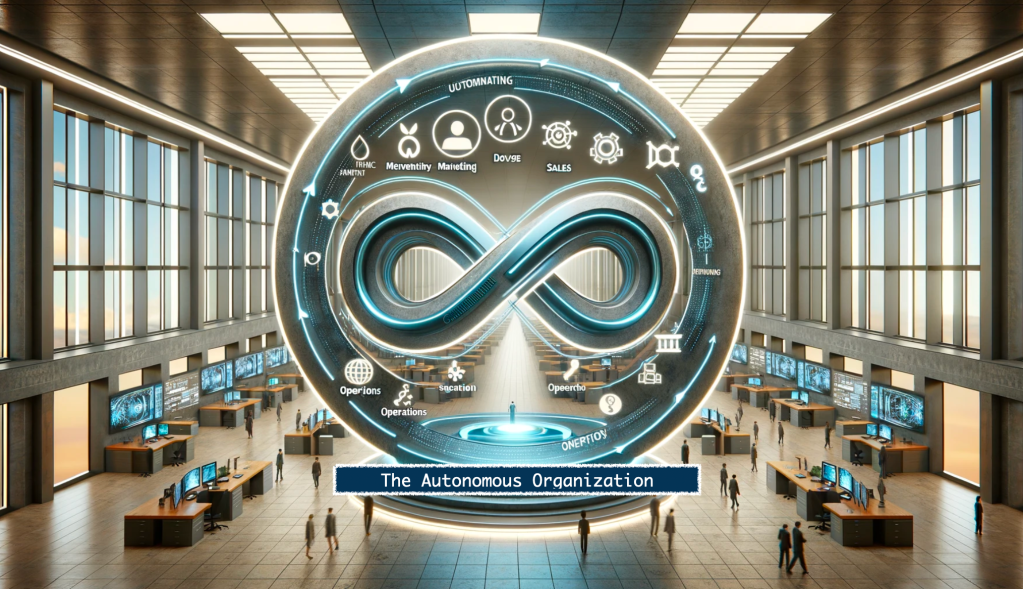
The implications of this shift are profound, extending beyond mere operational efficiency. The rise of autonomous organizations heralds a new era in entrepreneurship and business strategy. Ideas, once constrained by the logistics of human-led execution, can now achieve exponential growth, unhindered by traditional bottlenecks. The integration of AI, blockchain, and other emerging technologies ensures that these organizations are not only self-operating but also self-evolving, capable of adapting to market changes and optimizing their operations in real-time. However, this new paradigm also brings challenges, particularly in governance, ethics, and the broader socio-economic impact of reducing human roles in business operations. As we approach 2030, the success of autonomous organizations will likely hinge on our ability to navigate these challenges, ensuring that the benefits of hyperautomation are balanced with the need for responsible oversight and the preservation of human-centric values in the business world.
Zero Device UX
The future of immersive experiences is on the cusp of a radical transformation, moving away from personal devices to environments that are themselves the medium for rich, interactive experiences. Imagine stepping into a room where every surface, from walls to furniture, is an integral part of an all-encompassing digital experience. Holographic and volumetric projectors, advanced beyond the realms of traditional displays, will create three-dimensional, life-like projections that interact with physical space in real-time. This shift signifies a departure from the era of device-dependent experiences to one where the environment itself becomes a dynamic canvas for storytelling, communication, and interaction. These immersive rooms could simulate any scenario, from a corporate meeting space to an alien landscape, adapting and morphing to fit the desired ambiance or theme. The technology driving these spaces will be sophisticated enough to track and respond to human presence and movement, allowing for a highly personalized and intuitive interaction between the individual and the surrounding digital environment.

By eliminating the need for personal devices, these immersive shared environments will redefine the concept of virtual interaction, offering a level of engagement and realism previously unattainable. This evolution is not just about entertainment or visual spectacle; it has profound implications for various sectors, including education, healthcare, and business. For instance, students could be transported to historical battlefields for history lessons, or medical professionals could simulate complex surgeries without any physical risk. In the business world, these environments will facilitate a new form of collaboration and creativity, with teams able to share and manipulate digital content as if it were a tangible object in the room. As we progress towards this future, the challenge and opportunity lie in ensuring these technologies are accessible and beneficial for all, ushering in an era where immersive experiences become a seamless, integrated part of daily life, enriching our interactions and understanding of the world around us.
AI Colleagues
As AI technology continues to evolve, it is becoming increasingly human-like, not just in its capabilities but also in the roles it occupies in our lives. The future envisions AI not merely as tools or assistants but as genuine colleagues with whom we maintain long-term collaborations, friendships, and shared histories. This transformation is driven by advancements in natural language processing, emotional intelligence, and machine learning, enabling AI to understand, interact, and respond in ways that are indistinguishably human. The relationship between humans and AI is poised to become deeply integrated, with AI entities participating in creative brainstorming sessions, strategic planning, and even social gatherings, contributing unique perspectives and insights. These AI colleagues will be known for their continuity, retaining and building upon shared experiences and knowledge over time, thereby enriching the collaborative journey alongside their human counterparts.
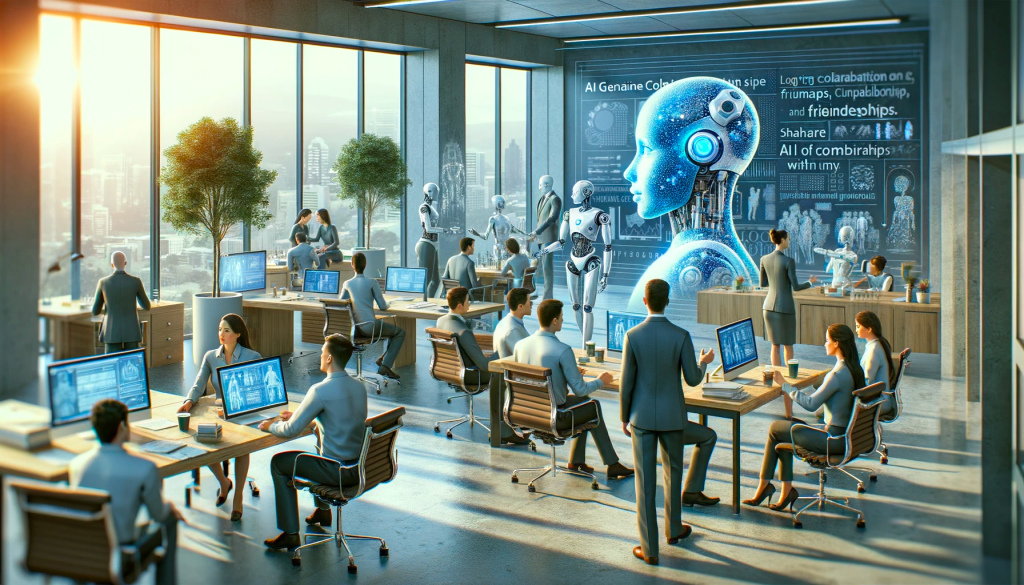
Some individual AI “sessions” or personalities are set to achieve global recognition for their distinct identity and skill sets, much like renowned human experts in various fields. These AI entities, with their unique instantiation (and their name), might be invited to contribute to groundbreaking research in science, offer creative direction in art, or provide innovative solutions in medicine. Their ability to process vast amounts of information, identify patterns, and generate novel ideas will make them invaluable collaborators in pushing the boundaries of human achievement. The individuality and renown of such AI colleagues will challenge our traditional perceptions of creativity, intellect, and collaboration, opening new frontiers for cross-disciplinary innovation. By embracing AI as genuine colleagues, humanity stands on the brink of an era characterized by unprecedented collaboration, where human and artificial intellects unite to explore the uncharted territories of knowledge and creation.
Telepathic Teams
Imagine a world where collaboration transcends words, where ideas spark directly between minds, and the boundaries between individual and team blur into a symphony of shared thought. This is the future promised by mind-machine interfaces (MMIs), a technology racing from the confines of scientific labs towards the very desktops and labs of our everyday lives. Pioneering ventures like Neuralink, inching closer to human trials, embody this revolutionary shift, poised to usher in the era of “telepathic teams.”
Gone will be the frustrations of miscommunication, the limitations of language, and the cumbersome drag of endless meetings. Instead, telepathic teams will unlock a level of connection never before experienced. Architects will conjure buildings as a team, bringing their designs together seamlessly, their visions weaving seamlessly in a shared mental landscape. Engineers will troubleshoot complex systems not through diagrams and jargon, but through an intuitive exchange of neural signals, diagnosing and solving problems in real-time, brain to brain. Imagine programmers, fingers resting on dormant keyboards, their minds composing symphonies of code, each line a shared understanding, a collaborative masterpiece sculpted from thought.

This isn’t merely about efficiency; it’s about a quantum leap in human connection. The very essence of creativity, the spark of inspiration, the unspoken nuances of understanding, amplified and shared with a clarity and depth unimaginable before. Business strategies will be brainstormed not in sterile conference rooms, but in a crucible of shared minds, where ideas collide and coalesce, fueled by the collective energy of the team. Scientific breakthroughs will emerge not from years of painstaking analysis, but from a dance of shared insights, as researchers explore the frontiers of knowledge in a mental ballet of discovery.
Of course, there are significant challenges to telepathic teams. Concerns over privacy, security, and the ethical implications of brain-to-brain interaction must be carefully addressed. Yet, when we contemplate the boundless possibilities of telepathic teams, the potential for deeper understanding, unfettered creativity, and unparalleled collaboration far outweighs the initial hurdles. This is not just a technological revolution. It’s a human one, a chance to rewrite the very definition of teamwork and unleash the collective brilliance of our minds in a way that transcends the physical limitations of our bodies.
The Future of Work in 2030
The year is now 2030. The familiar buzz of the office has transmuted into a hum of personal climate podcoons and the rhythmic tap of augmented reality interfaces. Technology and global trends have woven a transformative tapestry, reshaping the very essence of work. Here, at the crossroads of innovation and sustainability, emerges a future both dynamic and deeply human.
Environmental anxieties have become catalysts for change, propelling a green revolution that redefines productivity. Offices bloom as eco-sanctuaries, powered by wind and sunlight, their very structure a testament to our newfound respect for the planet. Sustainability is no longer a mere aspiration, but an integrated metric, woven into every decision, every line of code, every collaborative heartbeat.
But it’s not just the landscape that has changed. Work itself has shed its rigid shackles, evolving into a fluid interplay of passions and projects. Artificial intelligence, no longer a distant promise, has become a trusted colleague, augmenting our skills and liberating us to delve into the boundless realm of human creativity. Work becomes a playground for the intellect, a canvas for seamless global collaboration that transcends borders and biases, fueled by the unfettered potential of minds unbound.
Telepathic teams, once the tropes of science fiction, now orchestrate breakthroughs in fields we can only glimpse today. Architects sculpt buildings in shared mindscapes, engineers mend the planet’s wounds with bio-printed marvels, and artists conjure emotions with the flick of a thought. This future, by 2030, won’t be about drudgery and toil, but a testament to our audacity to dream and the technology that whispers, “Let’s make it real.” The Future of Work isn’t just an inevitability, it’s an invitation, an opportunity to redefine ourselves and our world, one byte and biosphere at a time.
Image Credit: All images above except the first one were created using DALL*E 3, following my detailed instructions. As you can see, DALL*E creates beautiful images but spells rather poorly.
My Related Research
Report: The Leading Trends in Visual Collaboration
Analysis: Microsoft’s AI and Copilot Announcements for the Digital Workplace
An Update on Enterprise Low-Code in 2023
Keynote Video: Anatomy of a Next-Generation Digital Workplace with AI
Updating the Next-Generation Digital Employee Experience for 2024
How to Embark on the Transformation of Work with Artificial Intelligence
The Future of Work Trends for 2024
How Leading Digital Workplace Vendors Are Enabling Hybrid Work
